This document provides an introduction to computers, programs, Java, and the basic components of a computer system. It discusses the objectives of understanding computer basics like the CPU, memory, storage devices, input/output, and how programs are run. It then provides details on programming languages like machine language, assembly language, and high-level languages like Java. It explains how source code is translated to machine code through interpreting or compiling. Finally, it discusses why Java is well-suited for developing applications on the Internet.

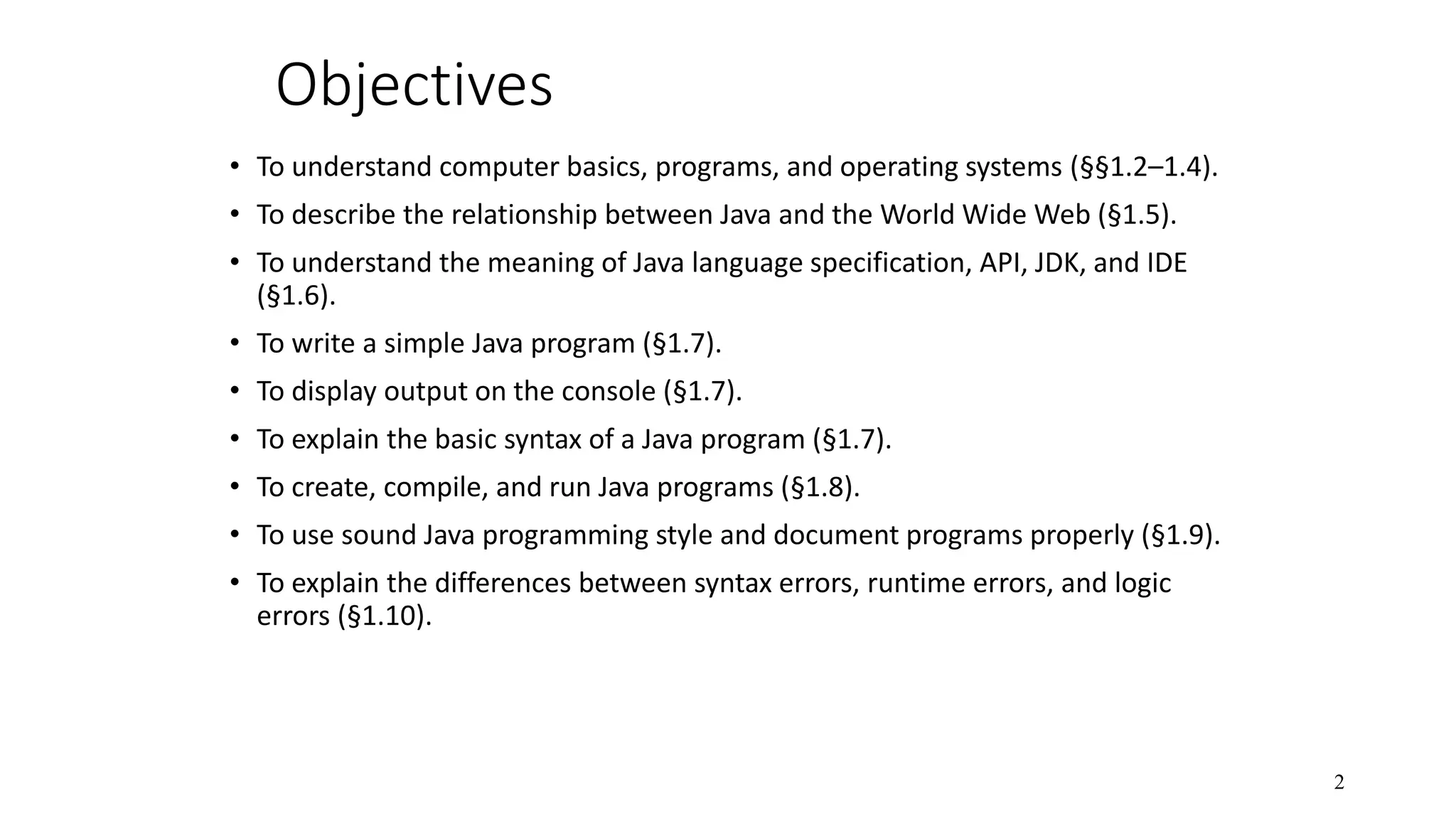
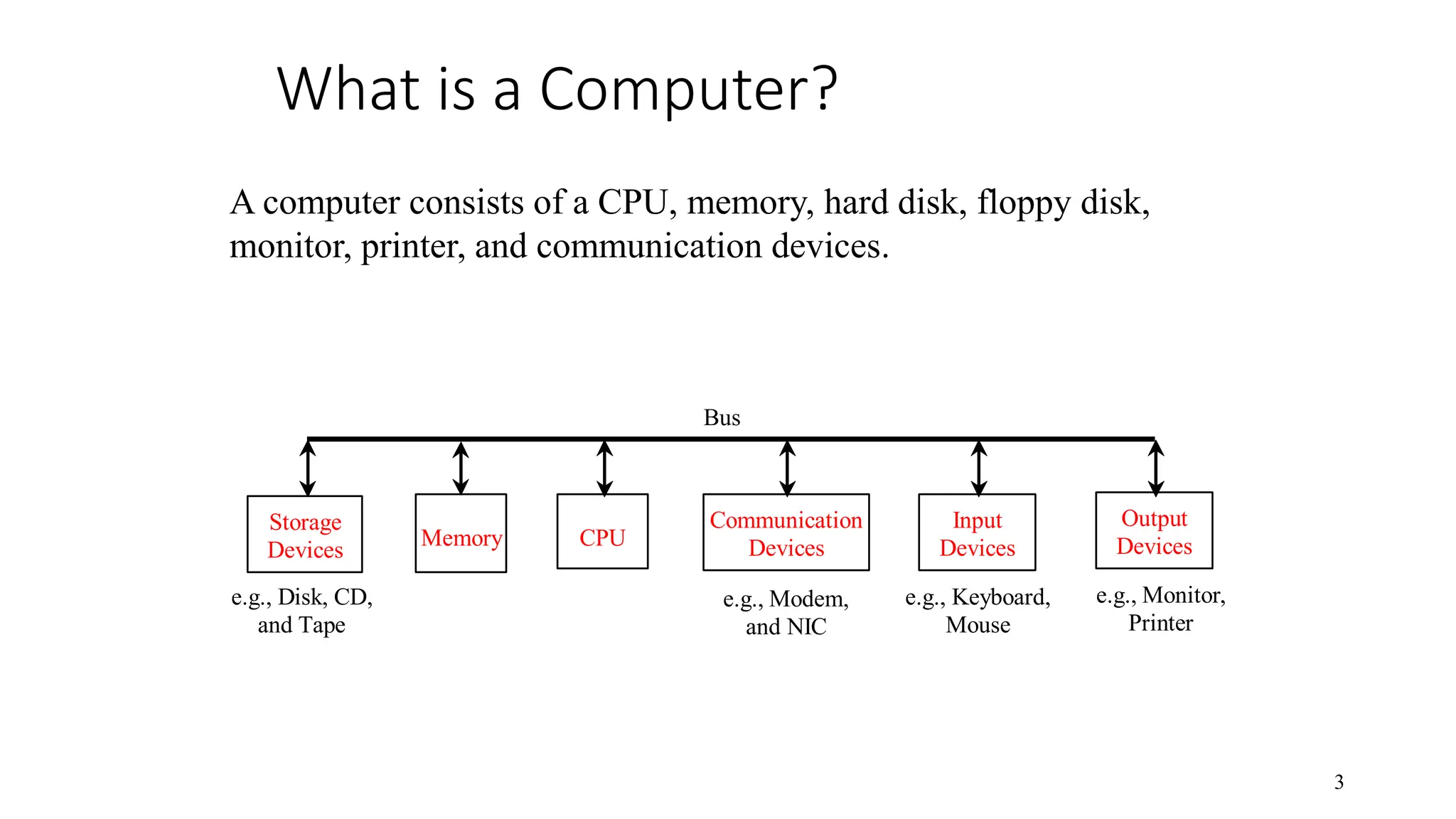
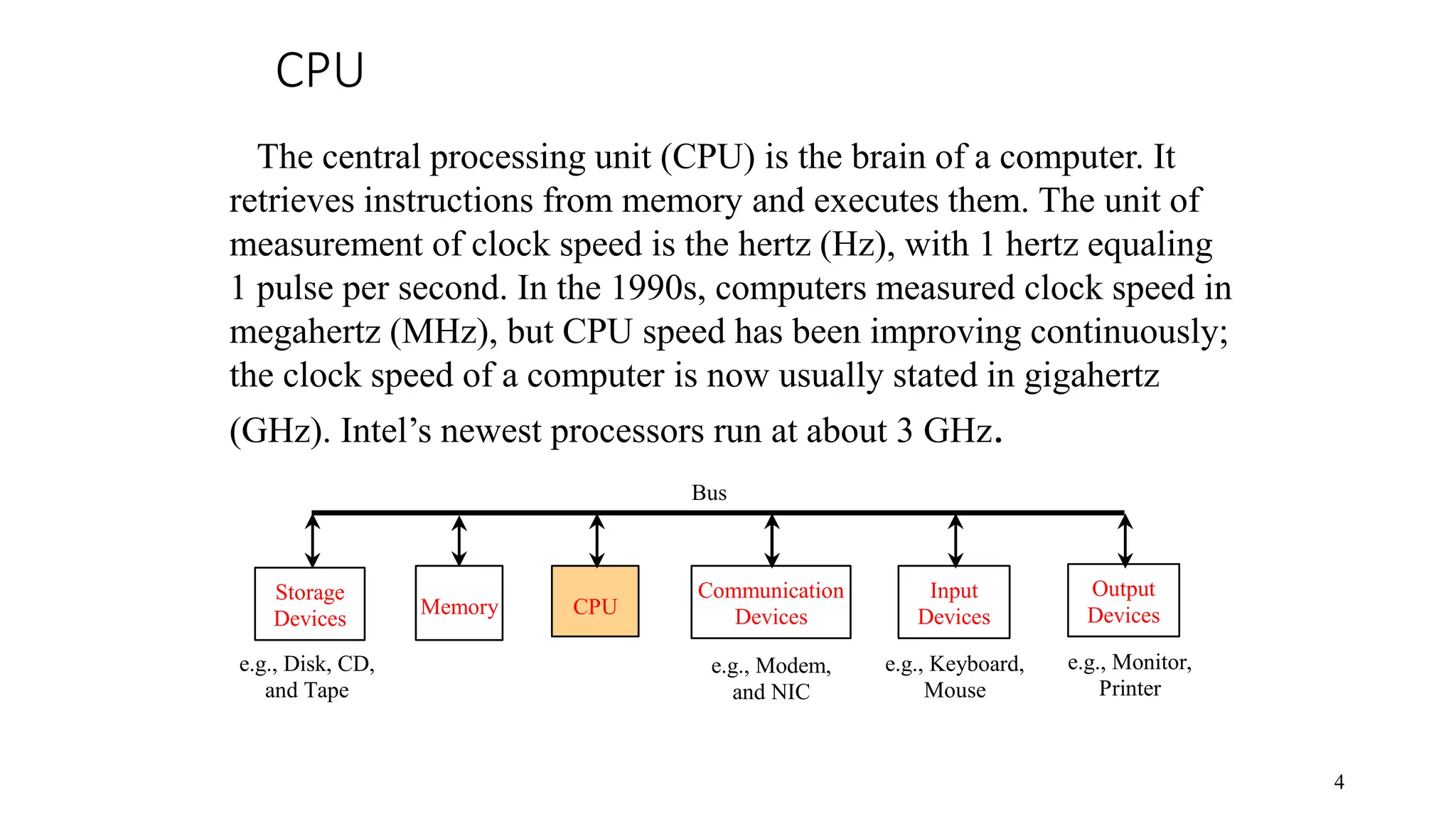

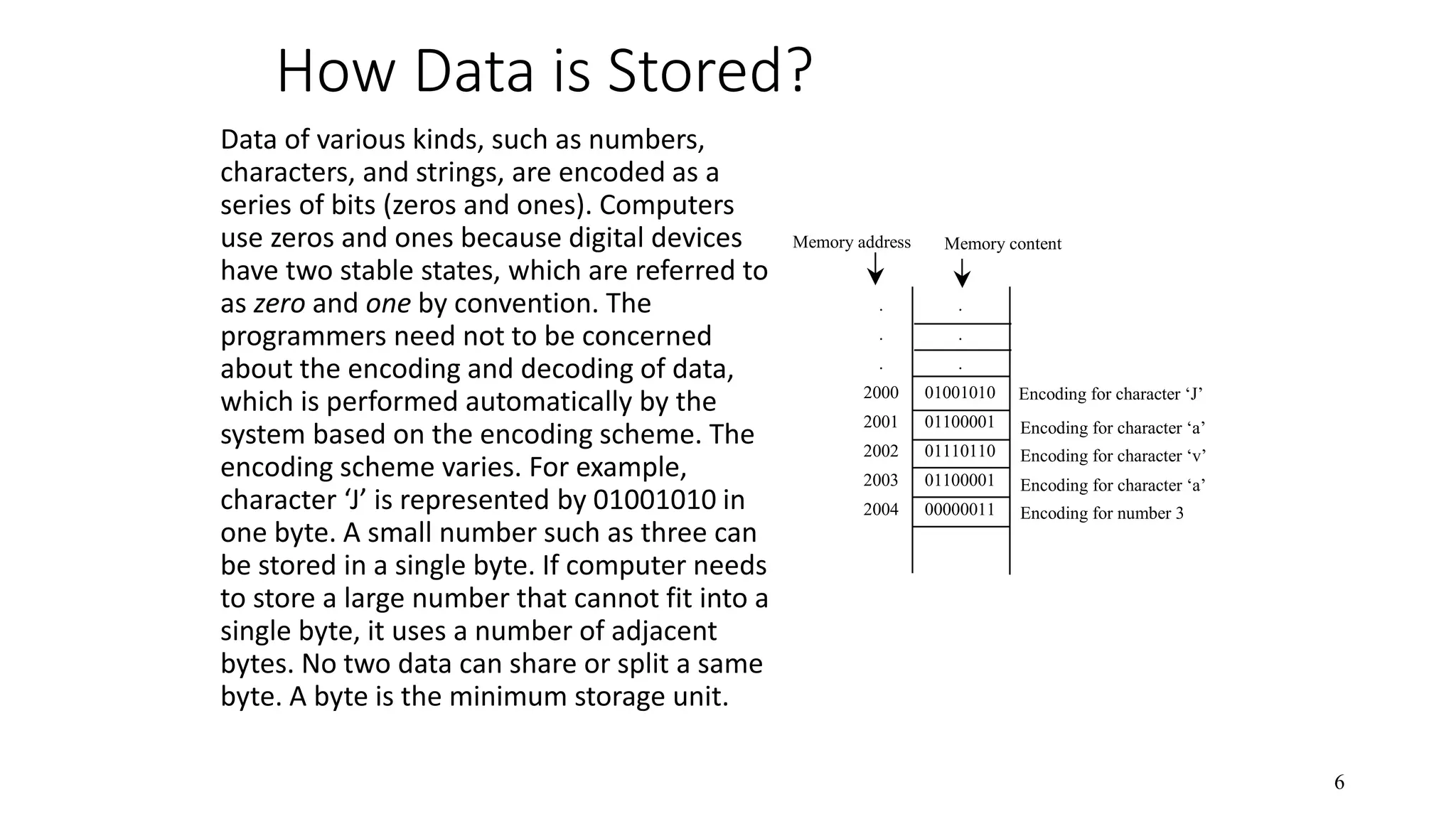

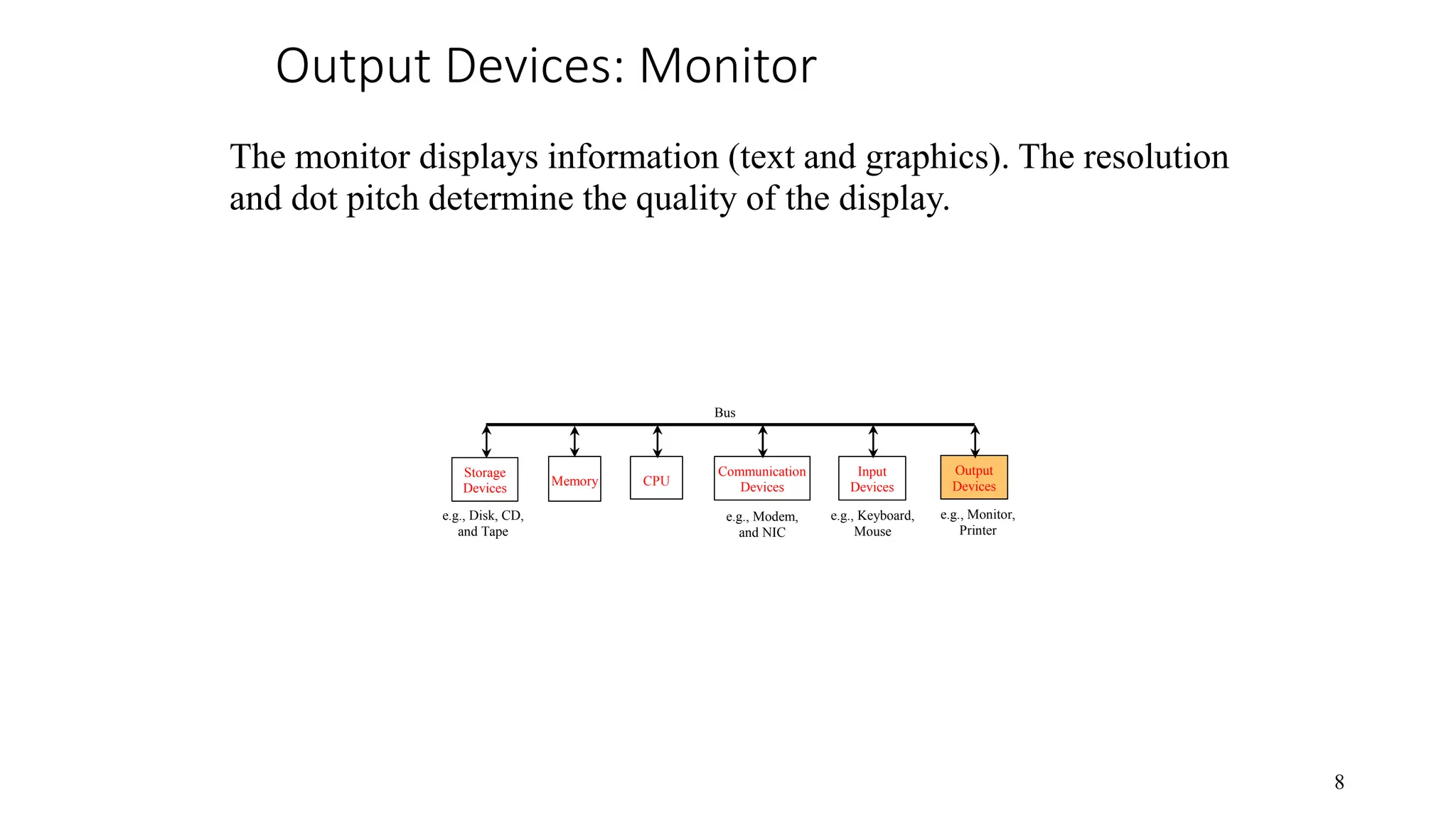
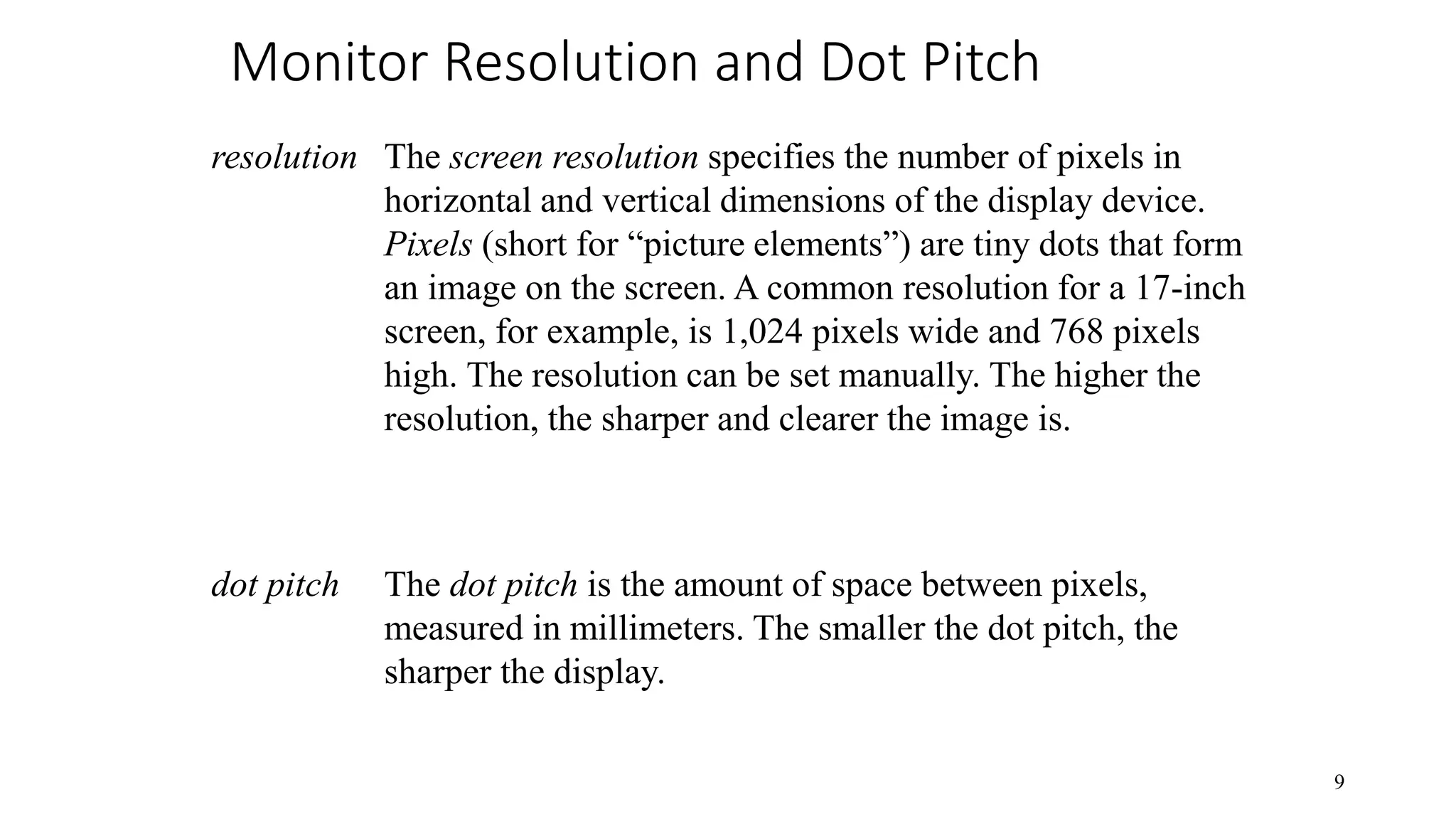
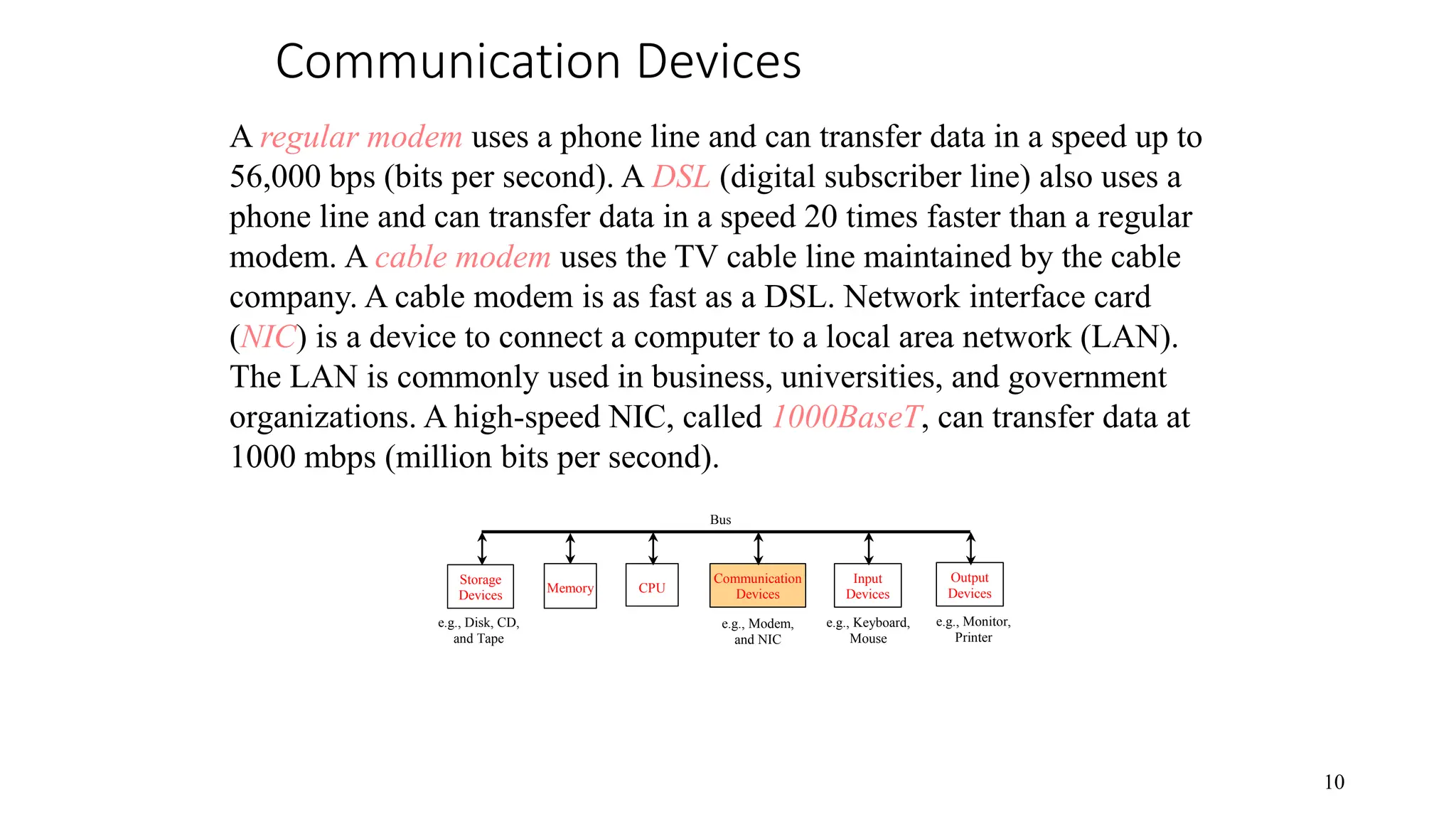

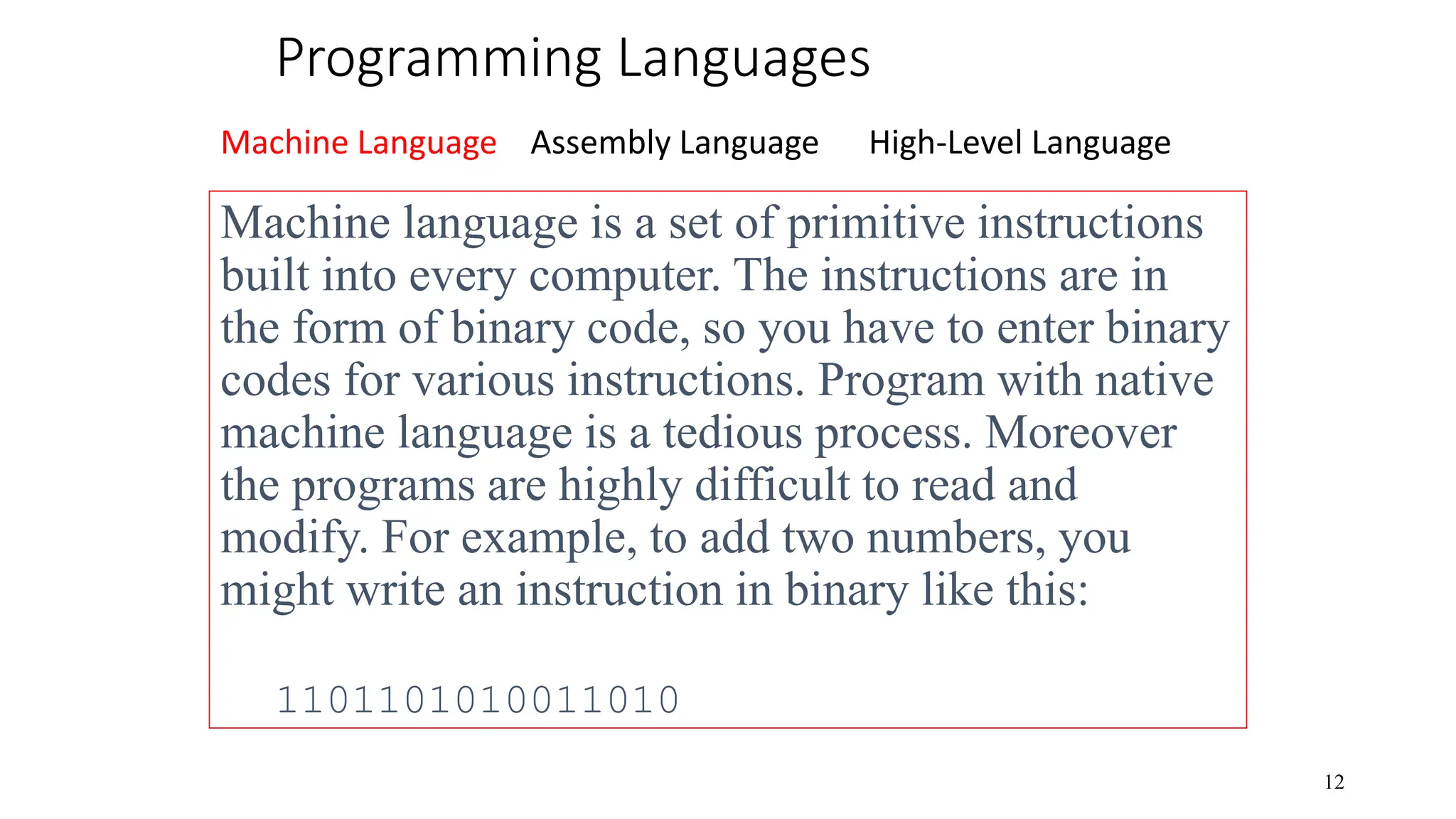
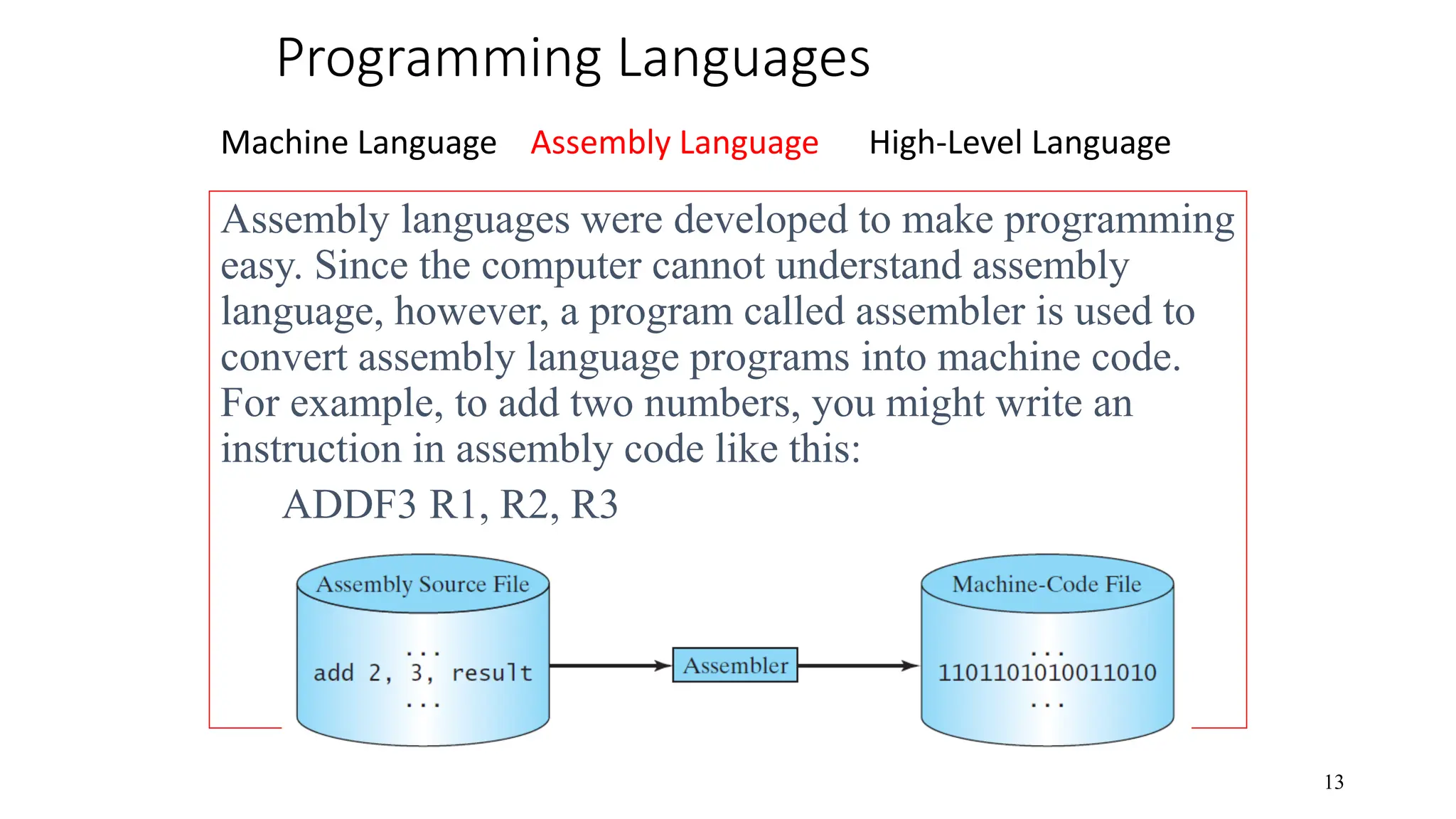
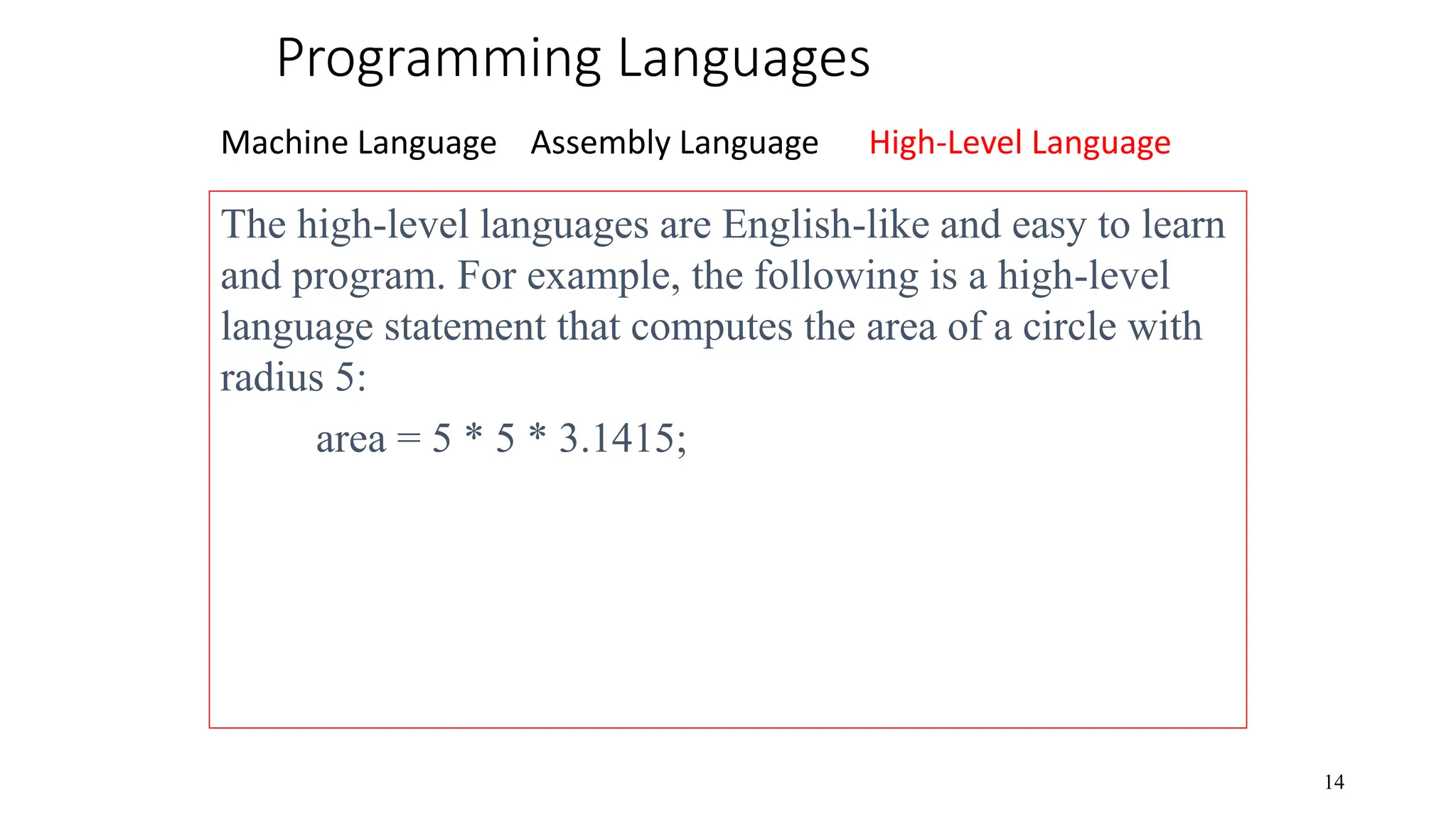

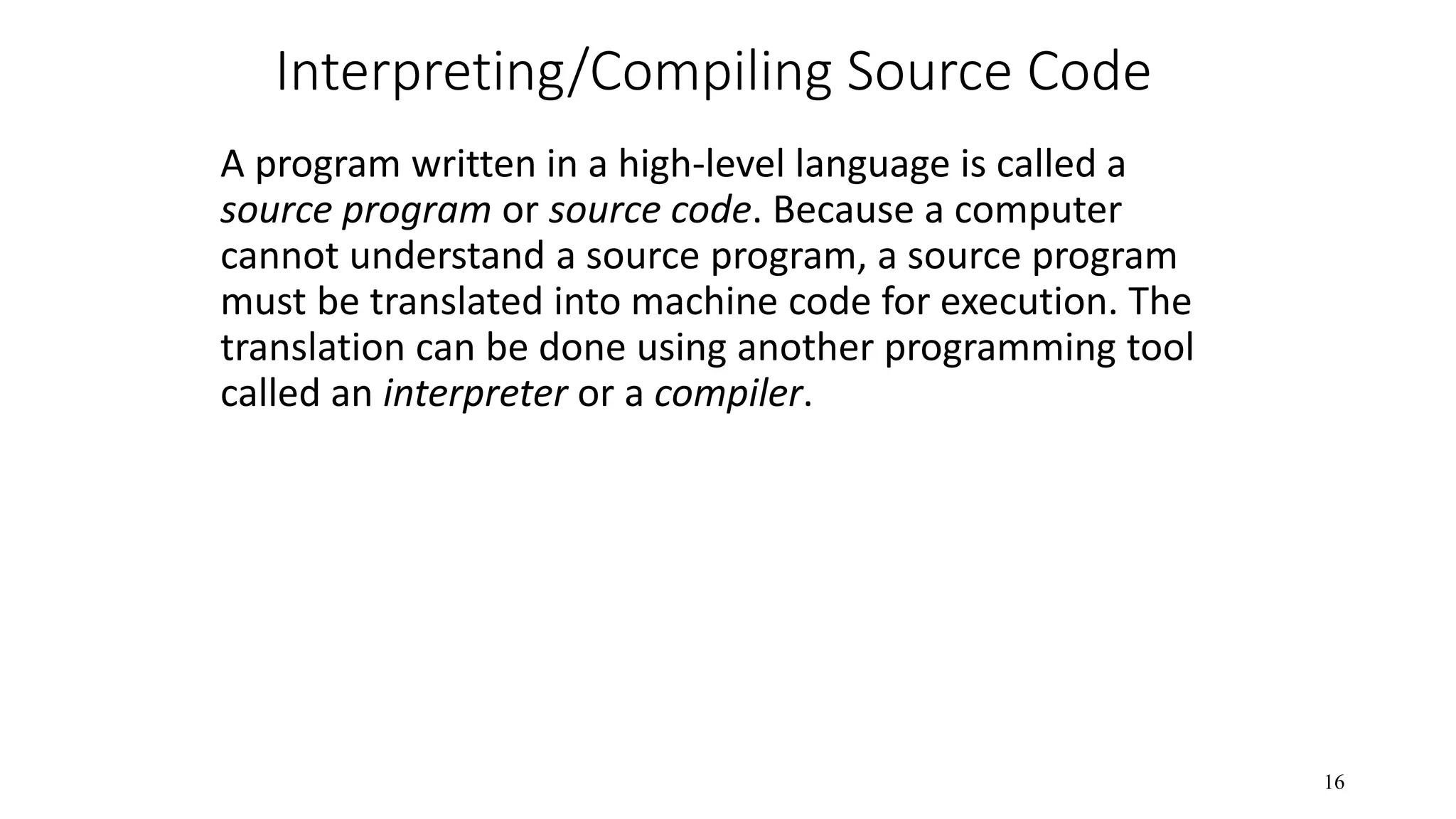

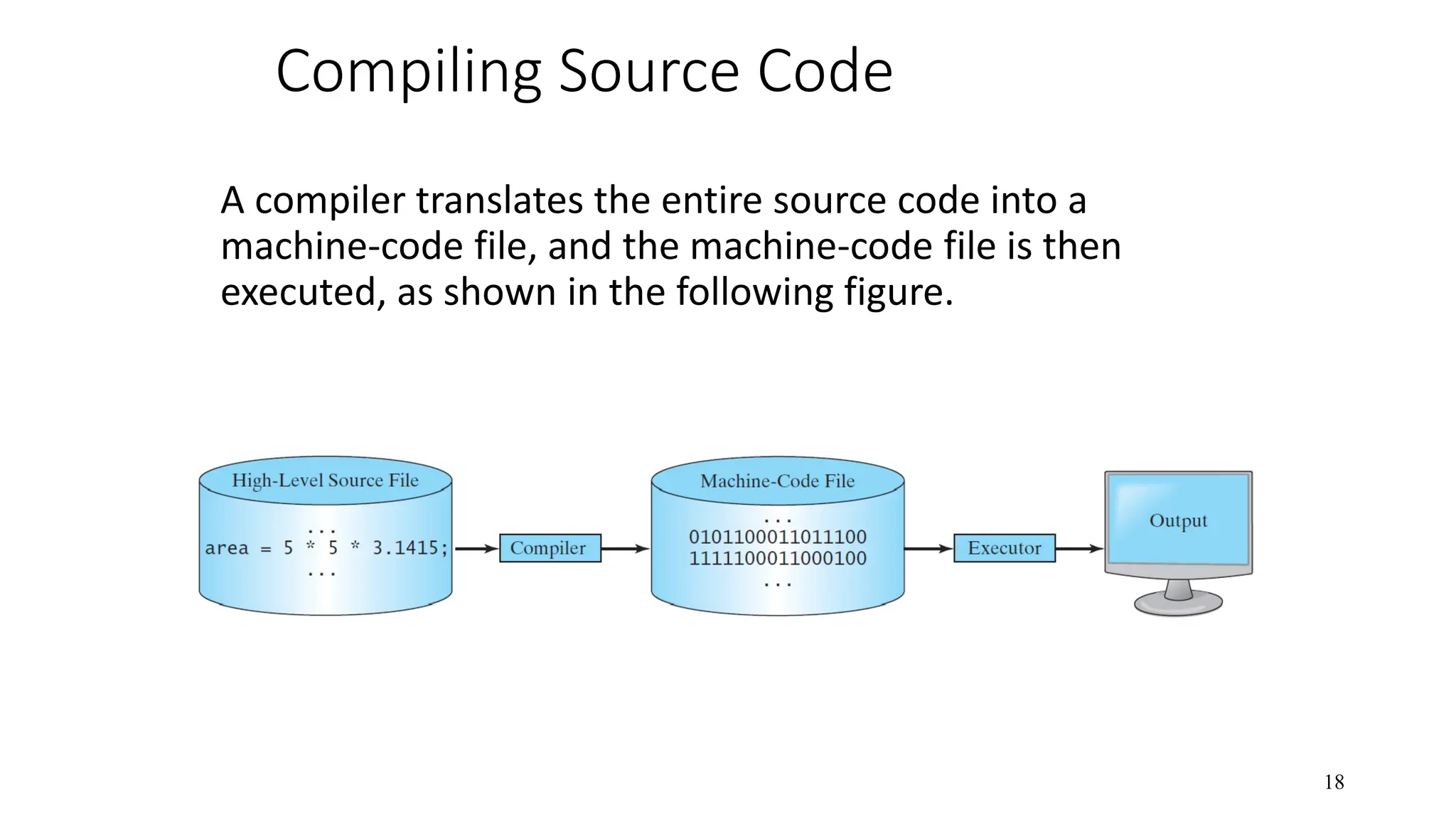
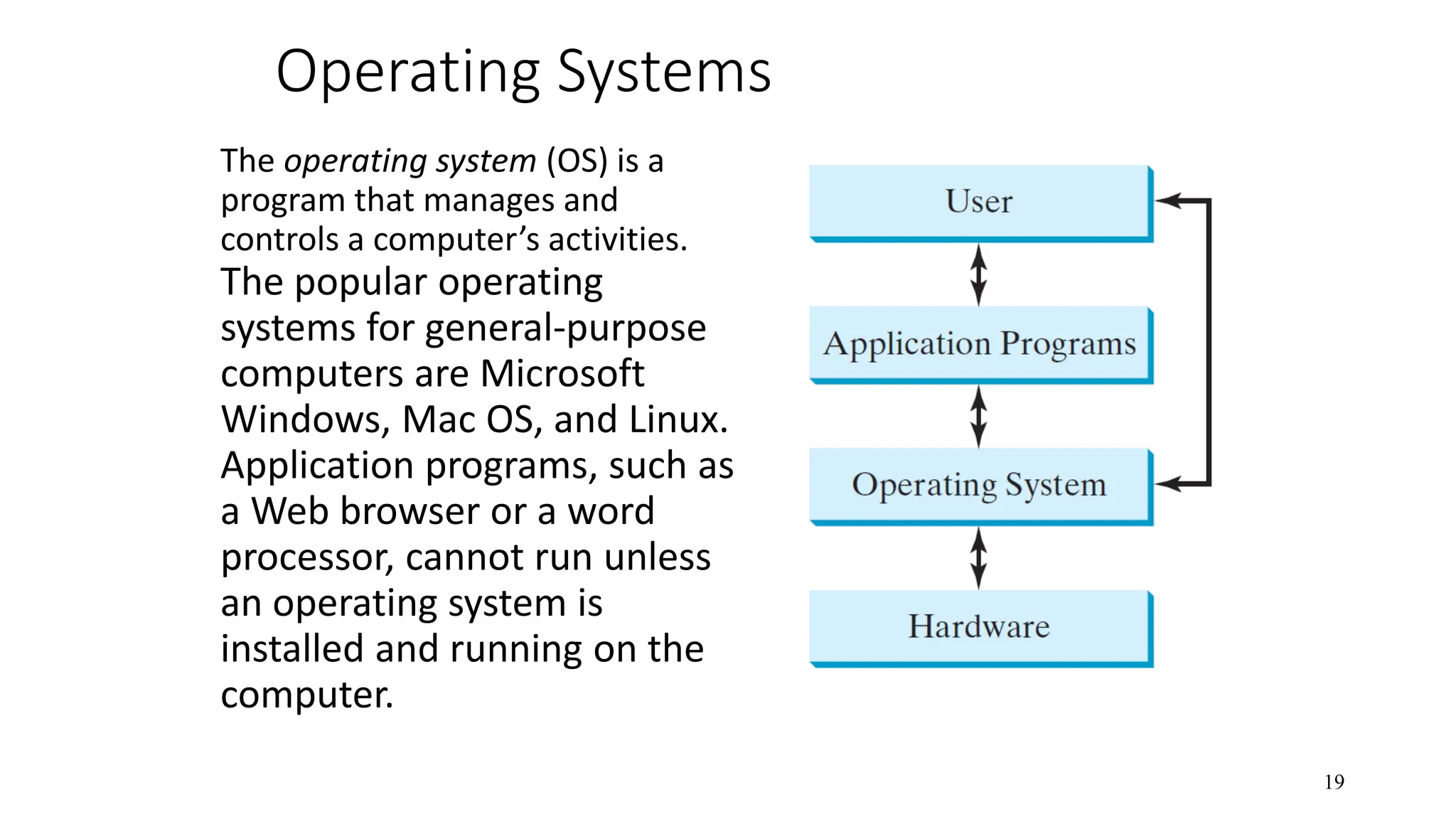
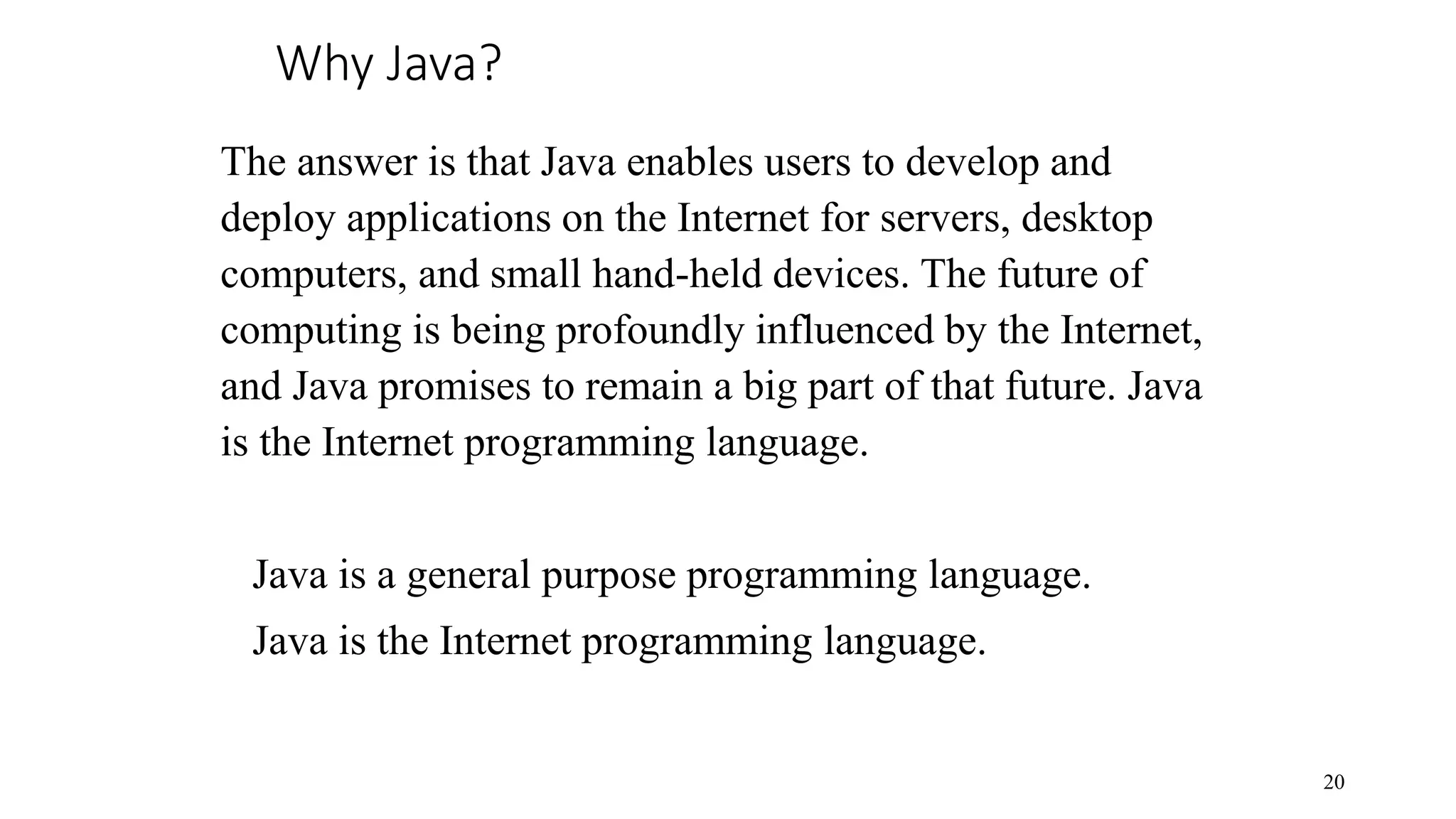
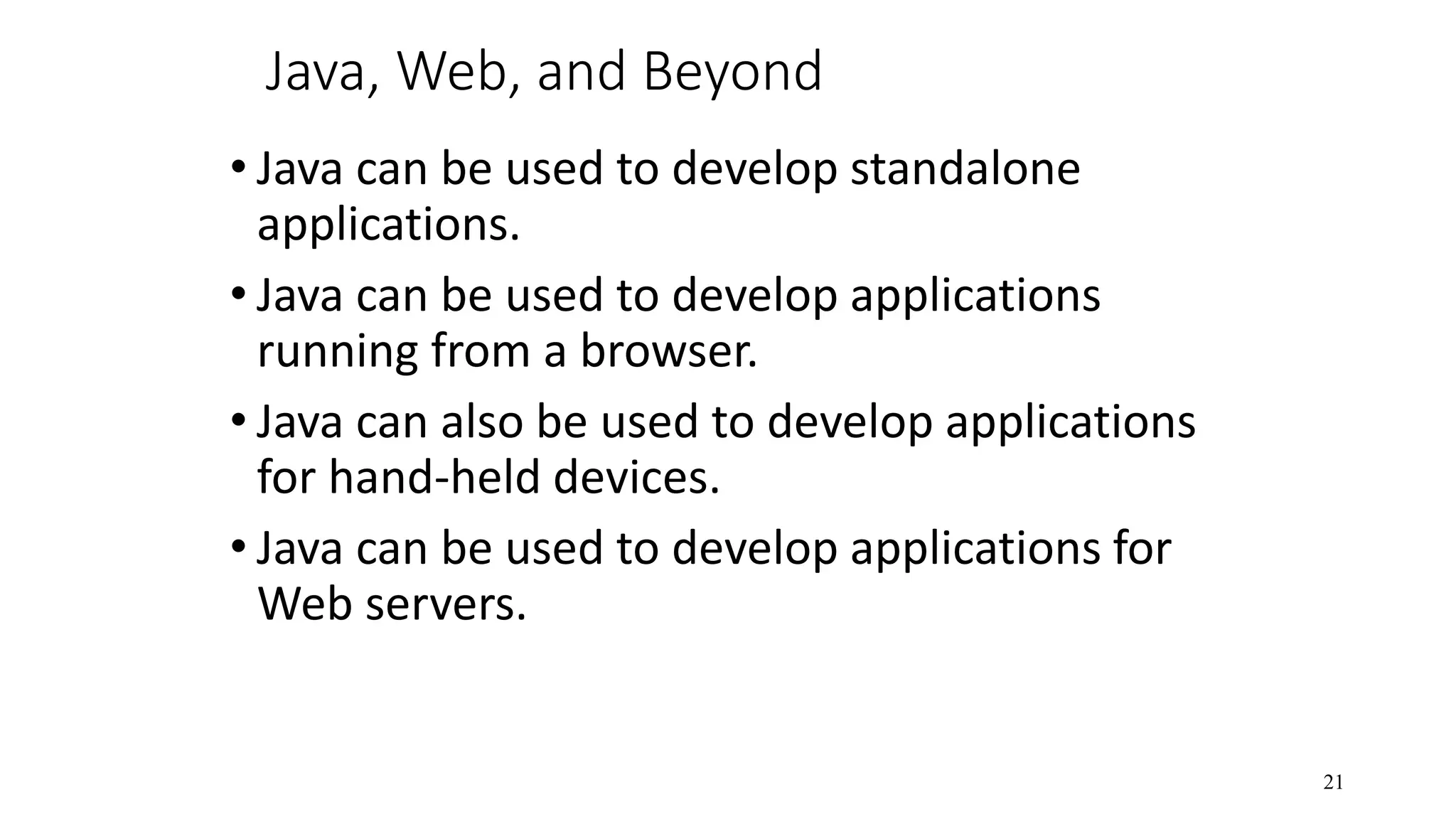
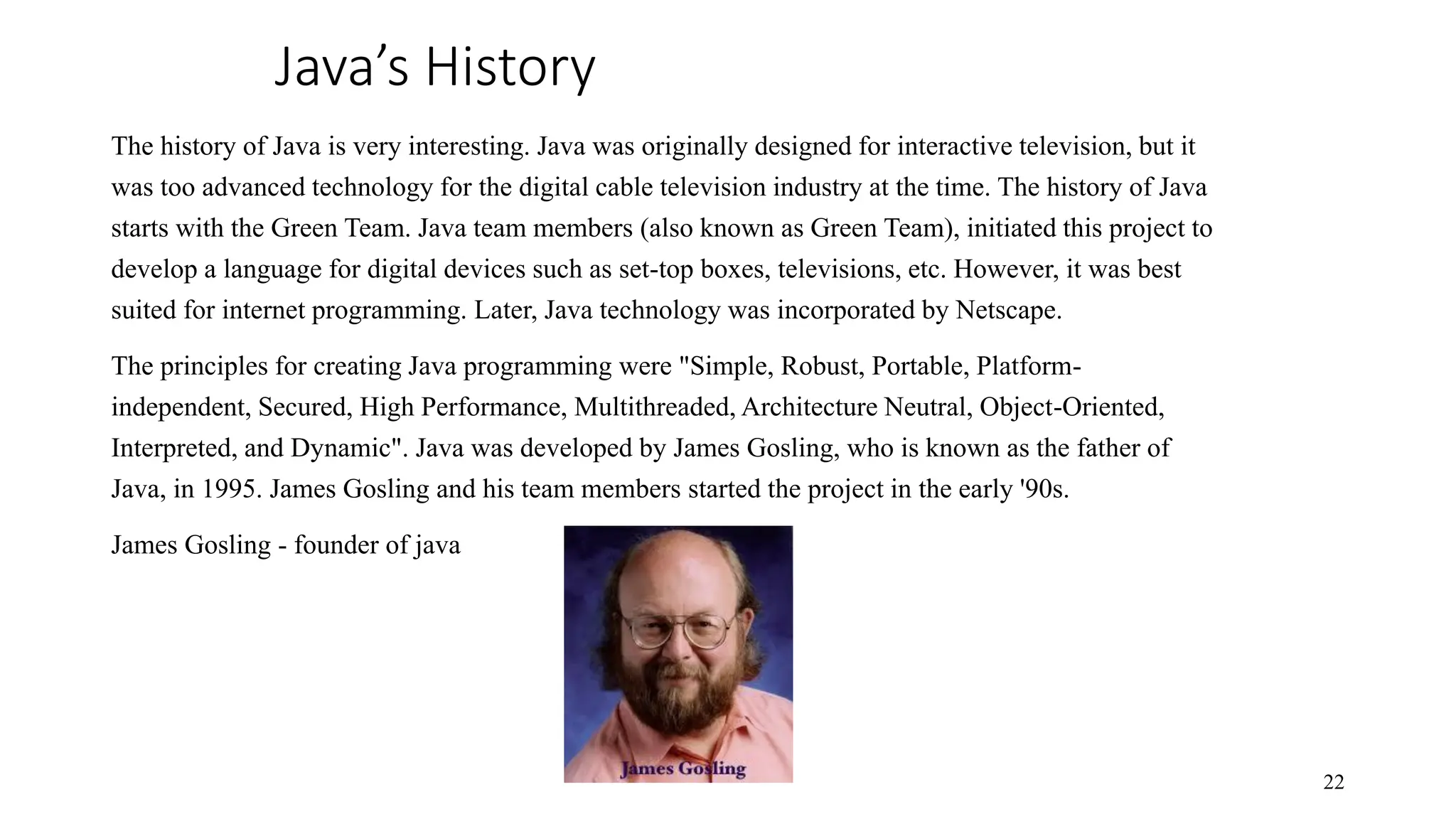
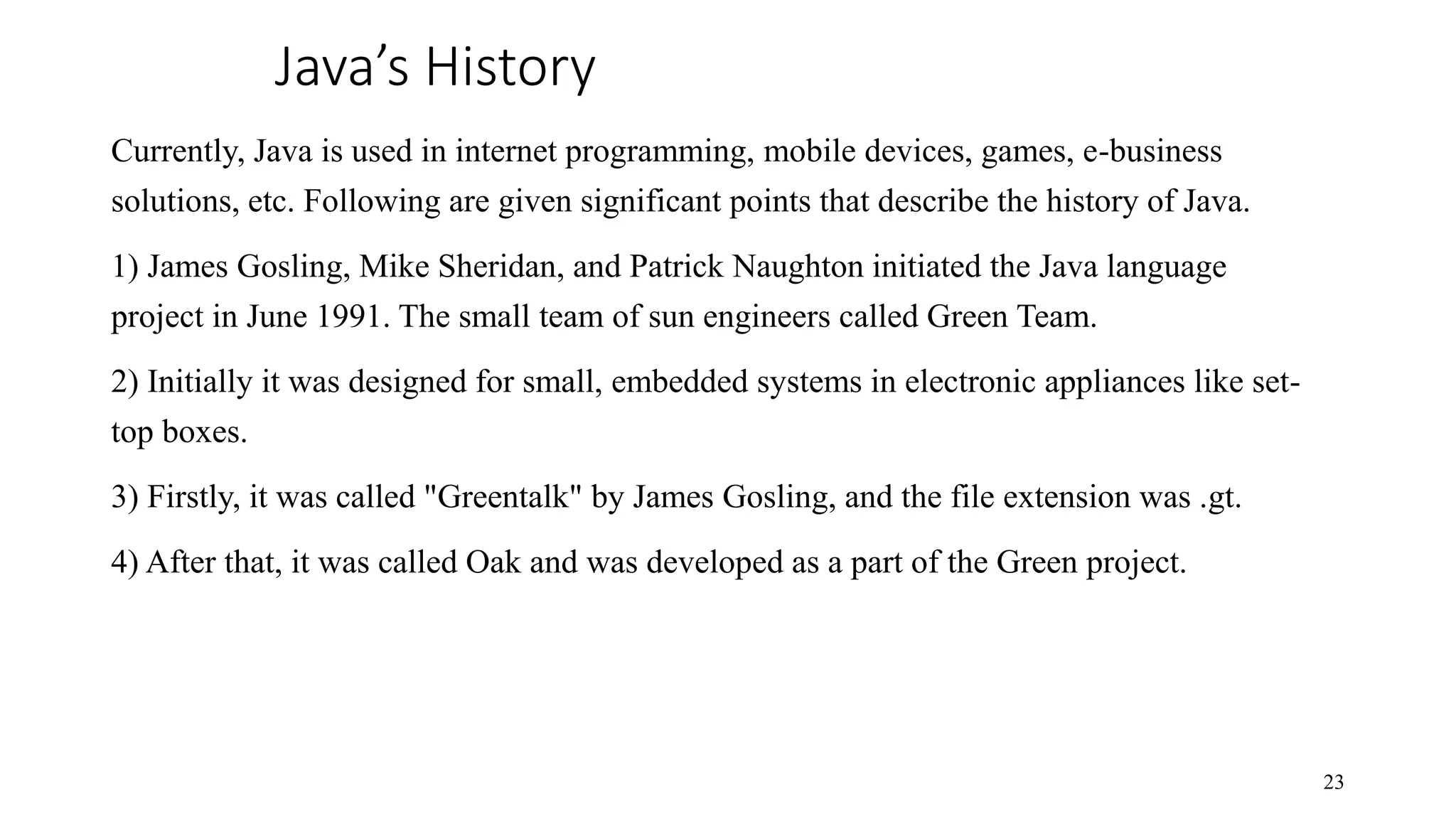
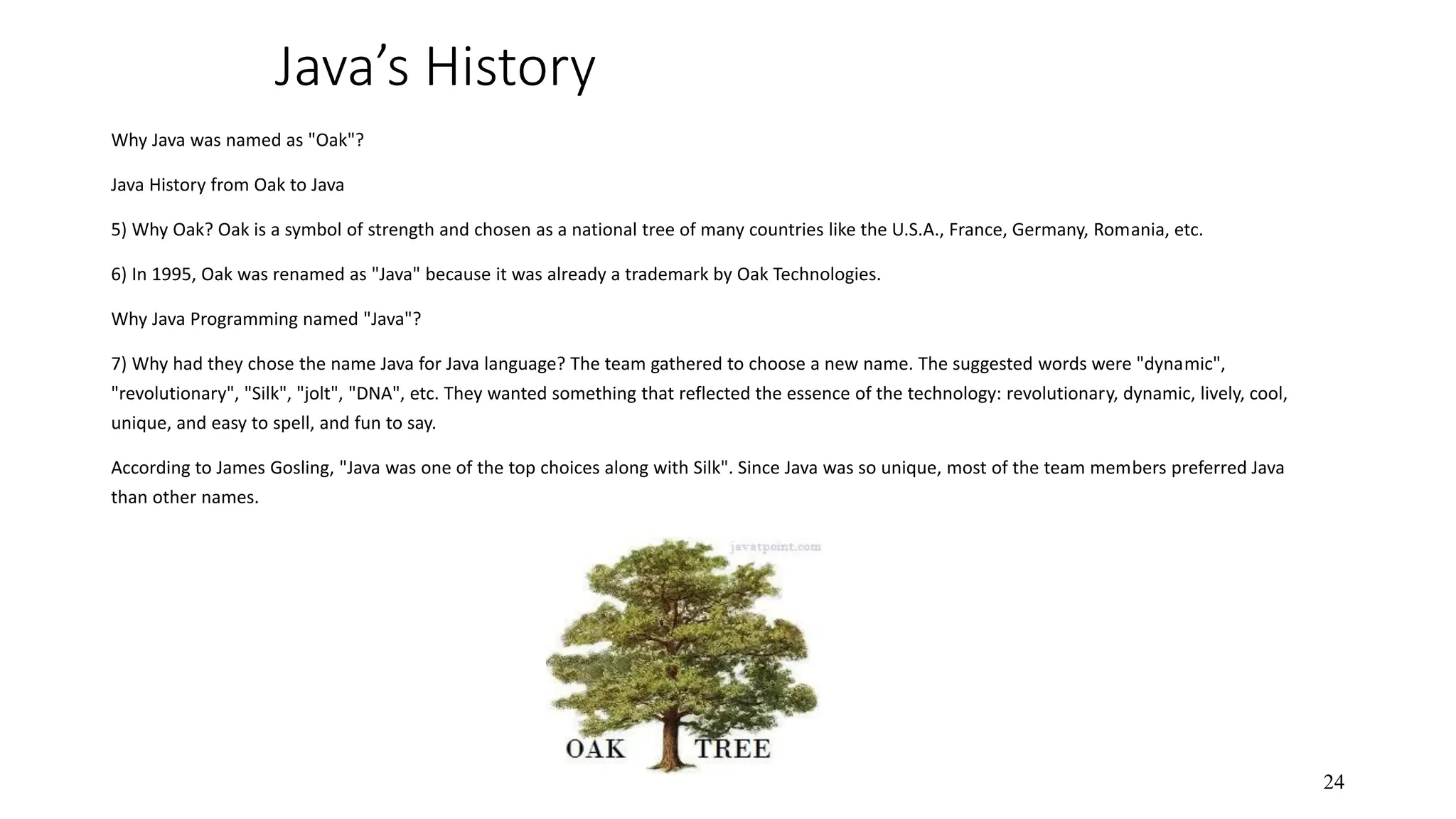
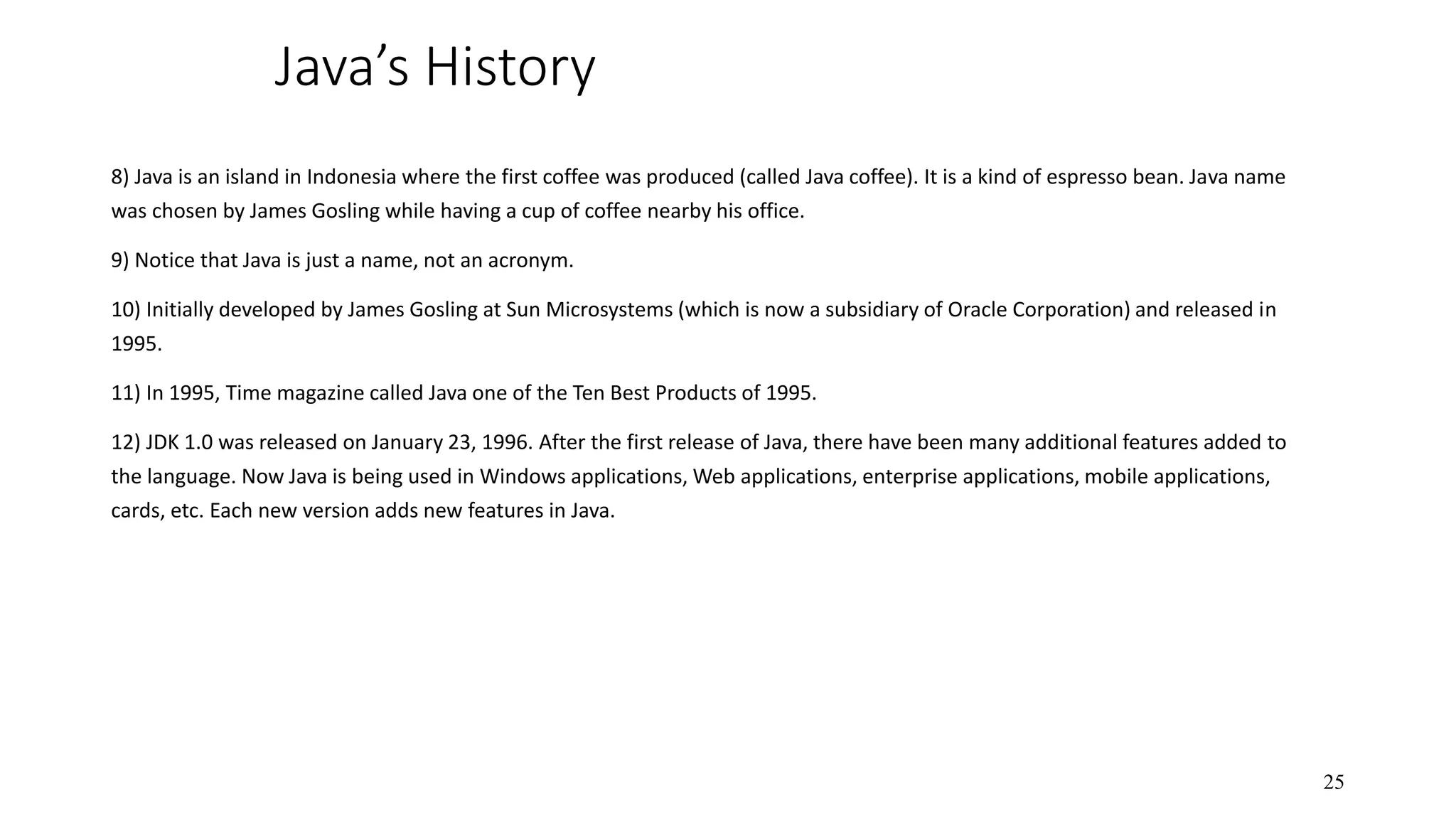

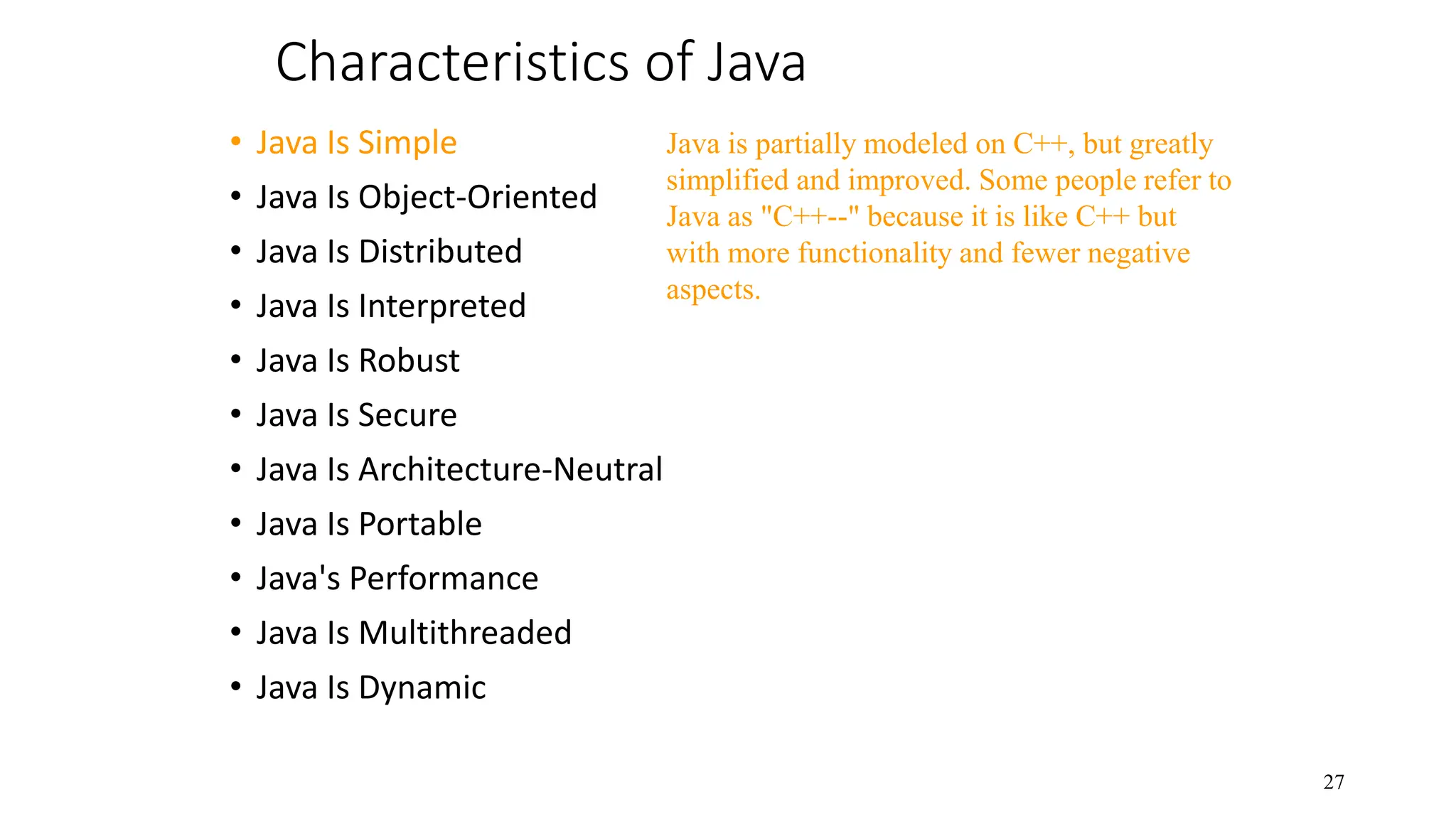
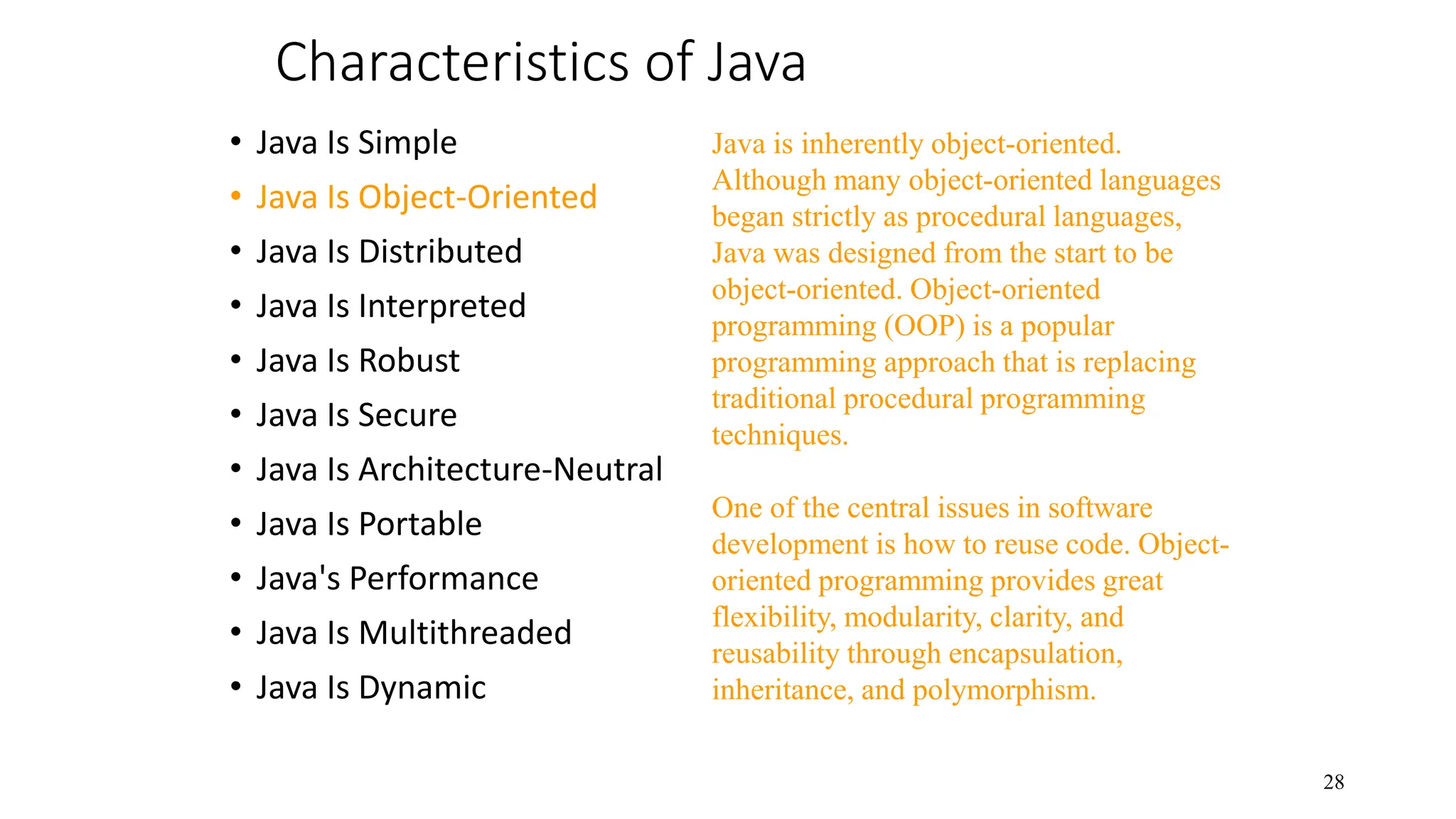

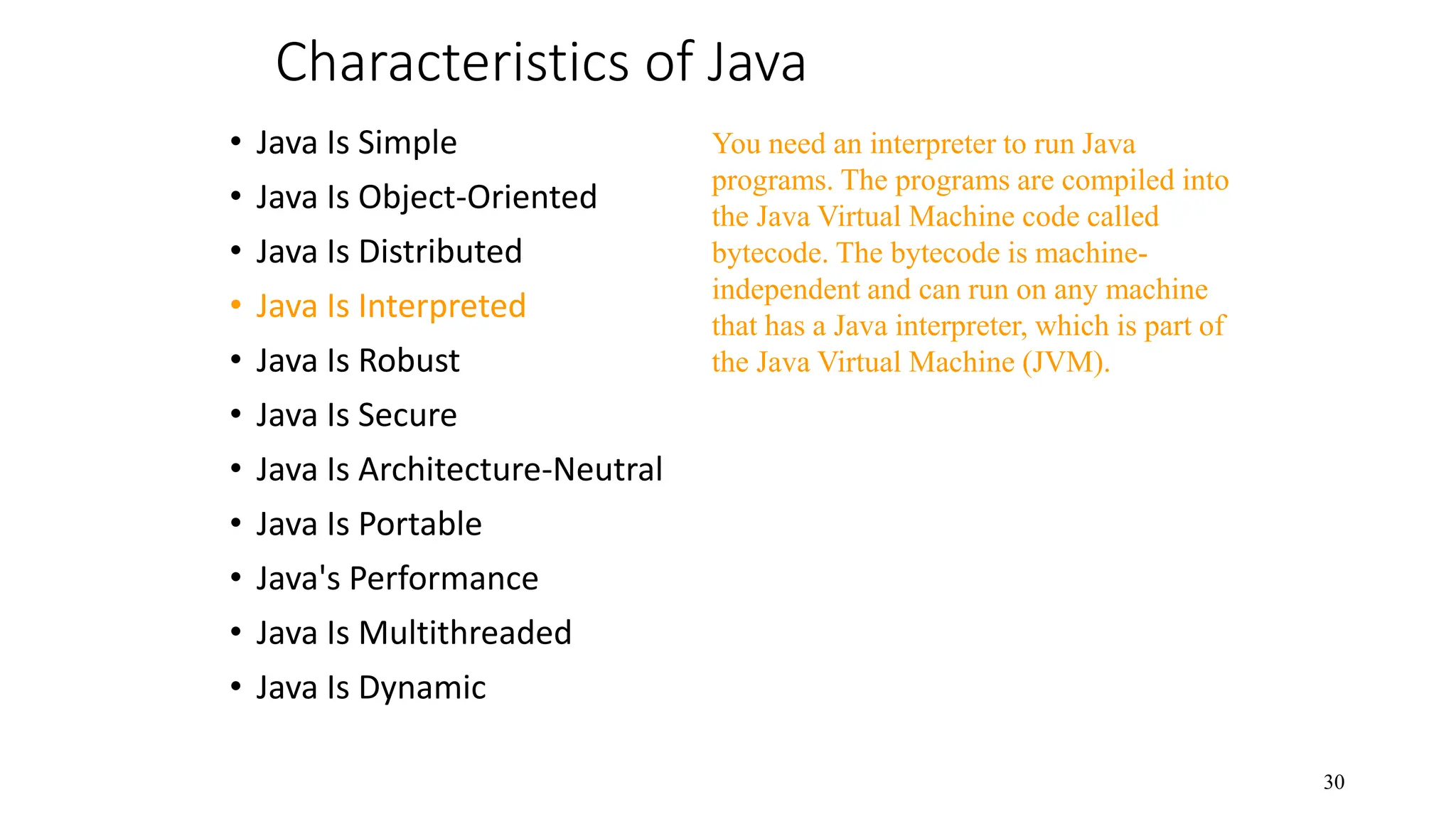
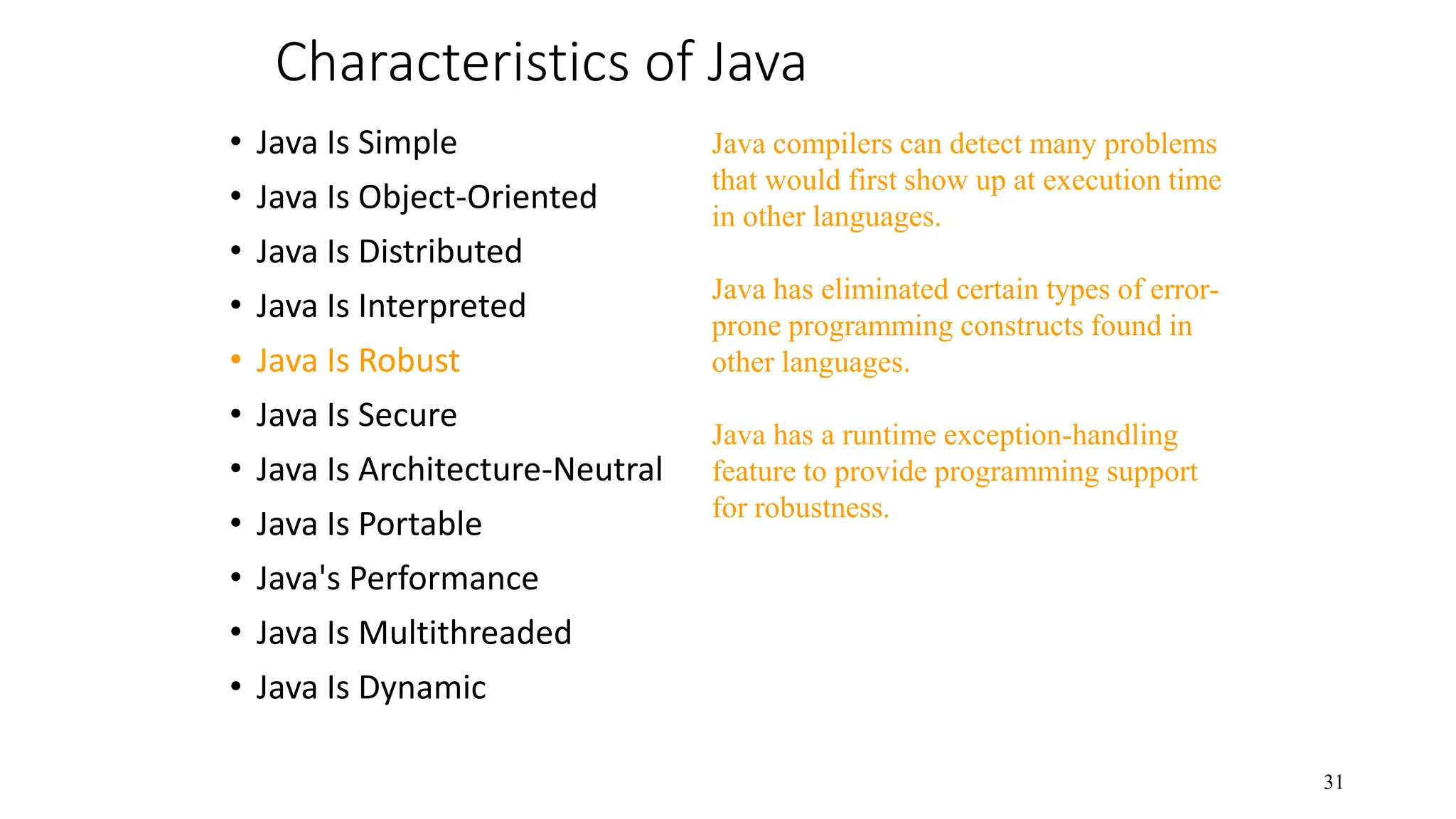
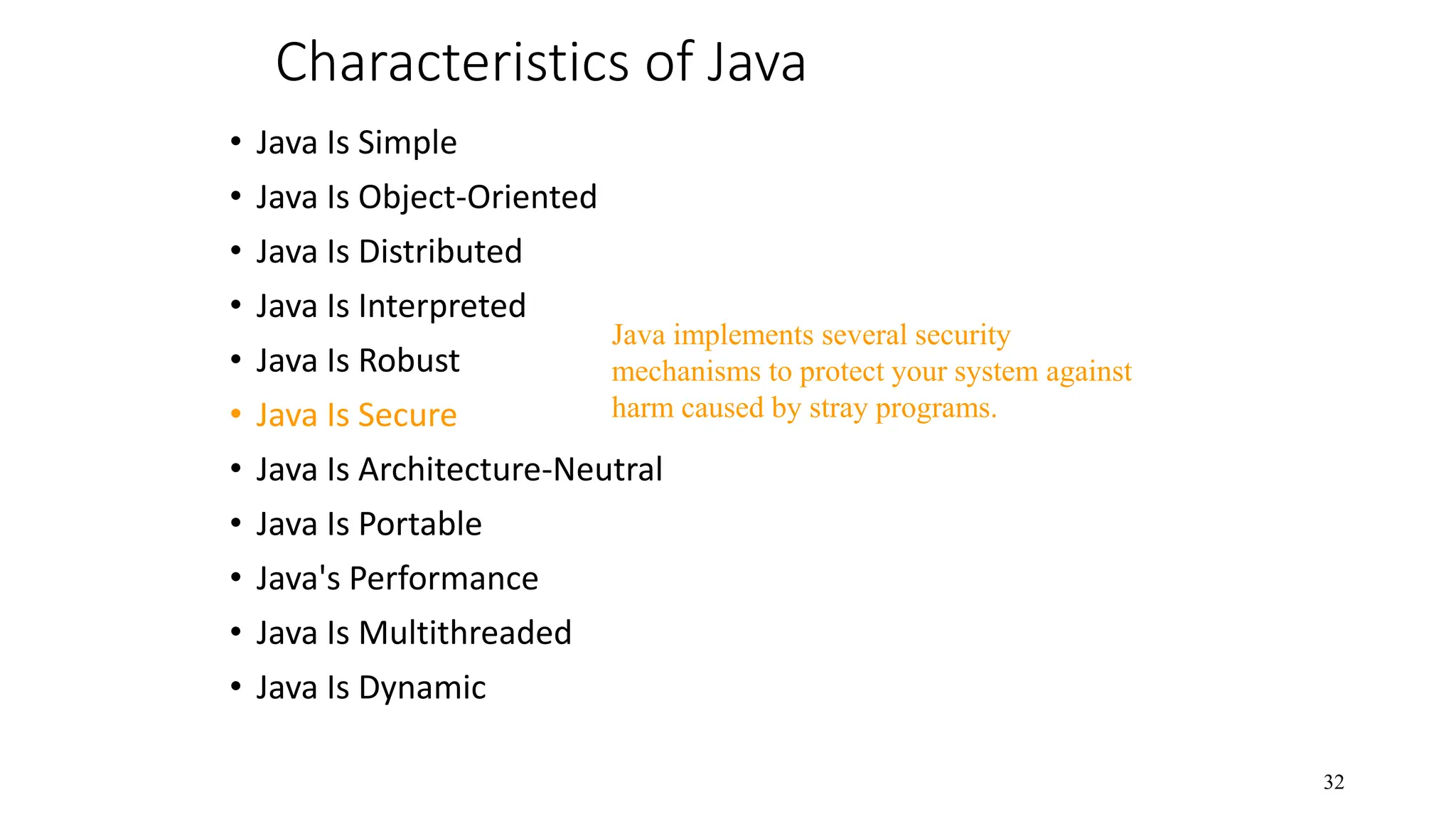
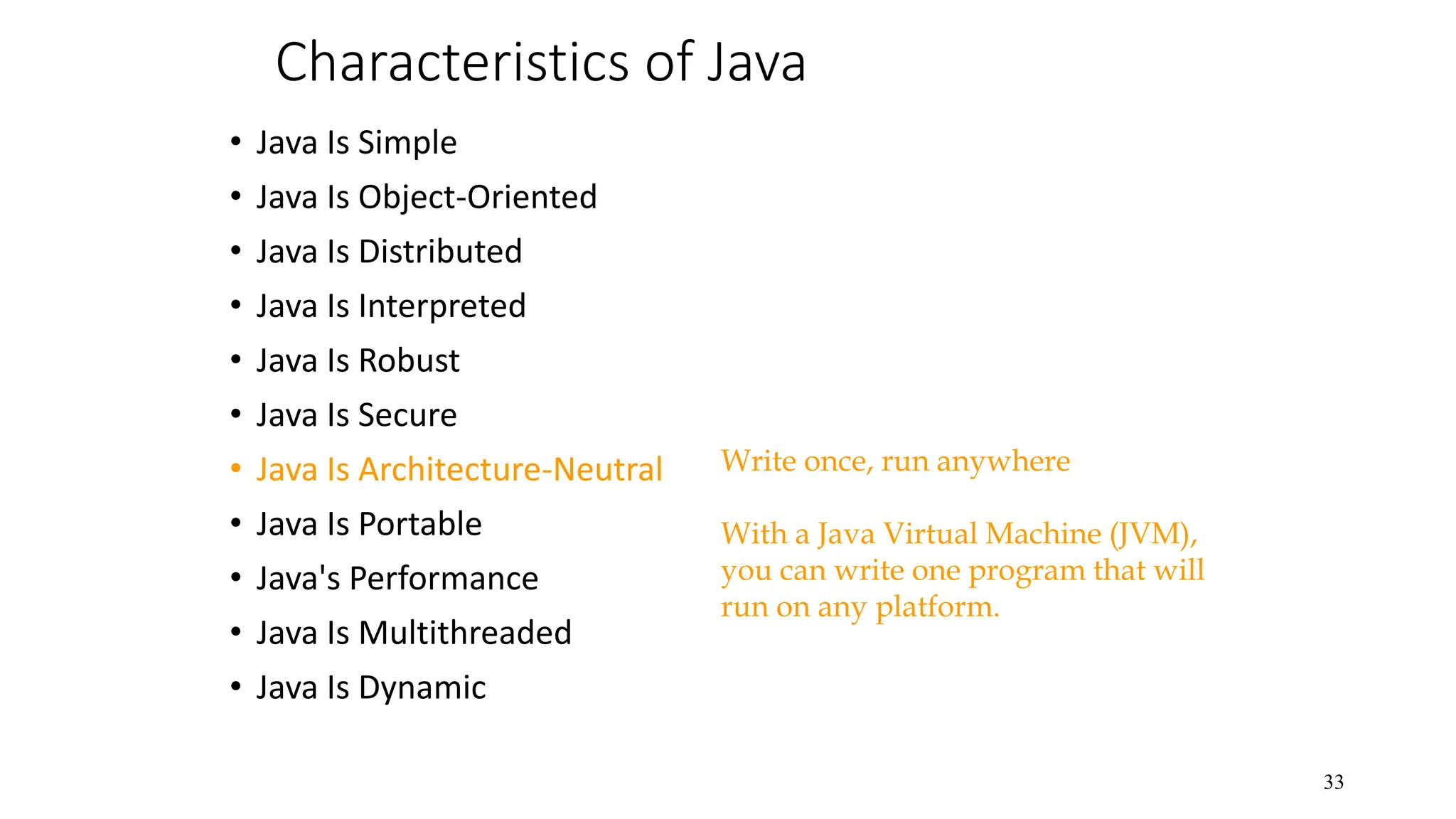

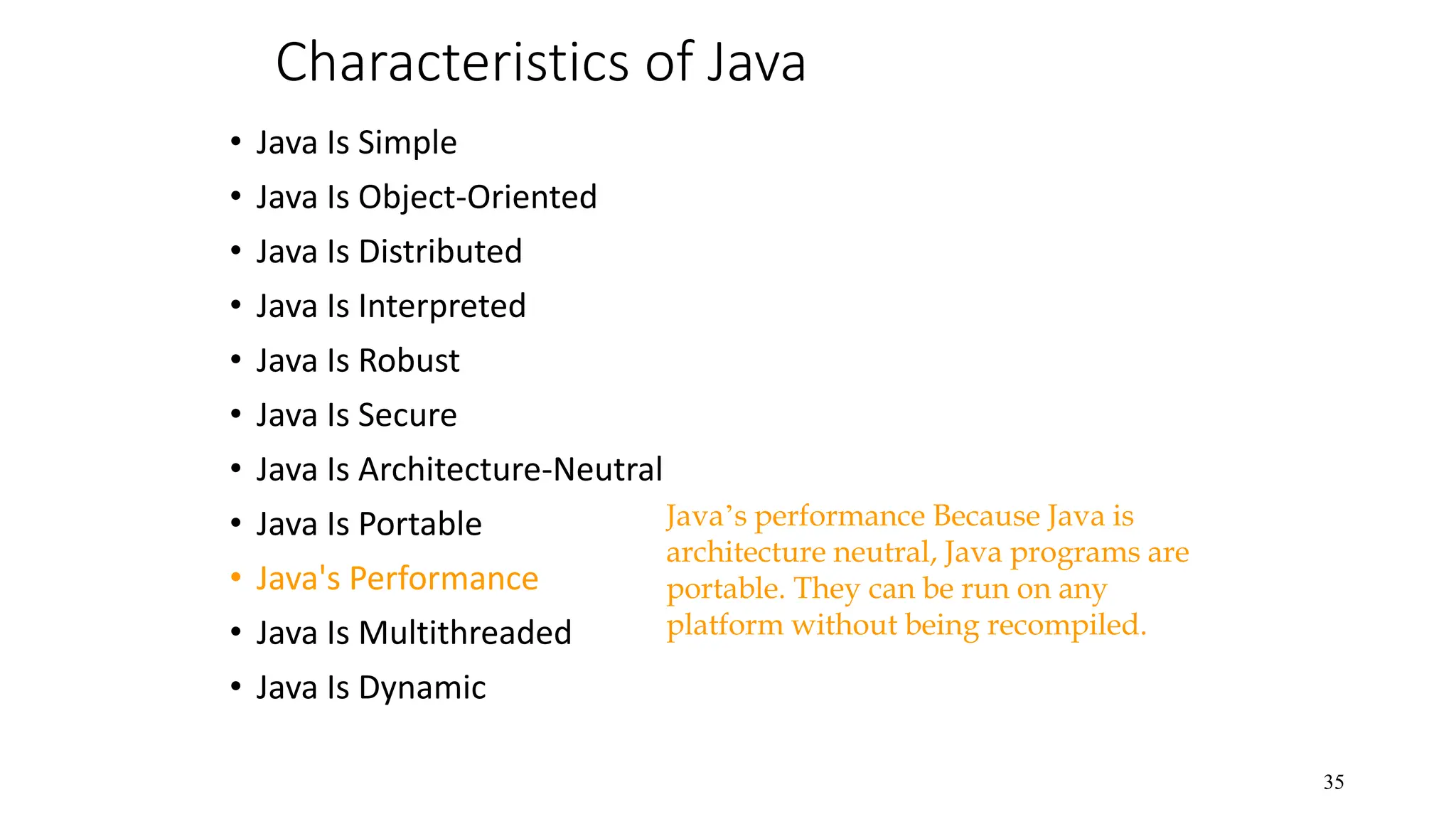

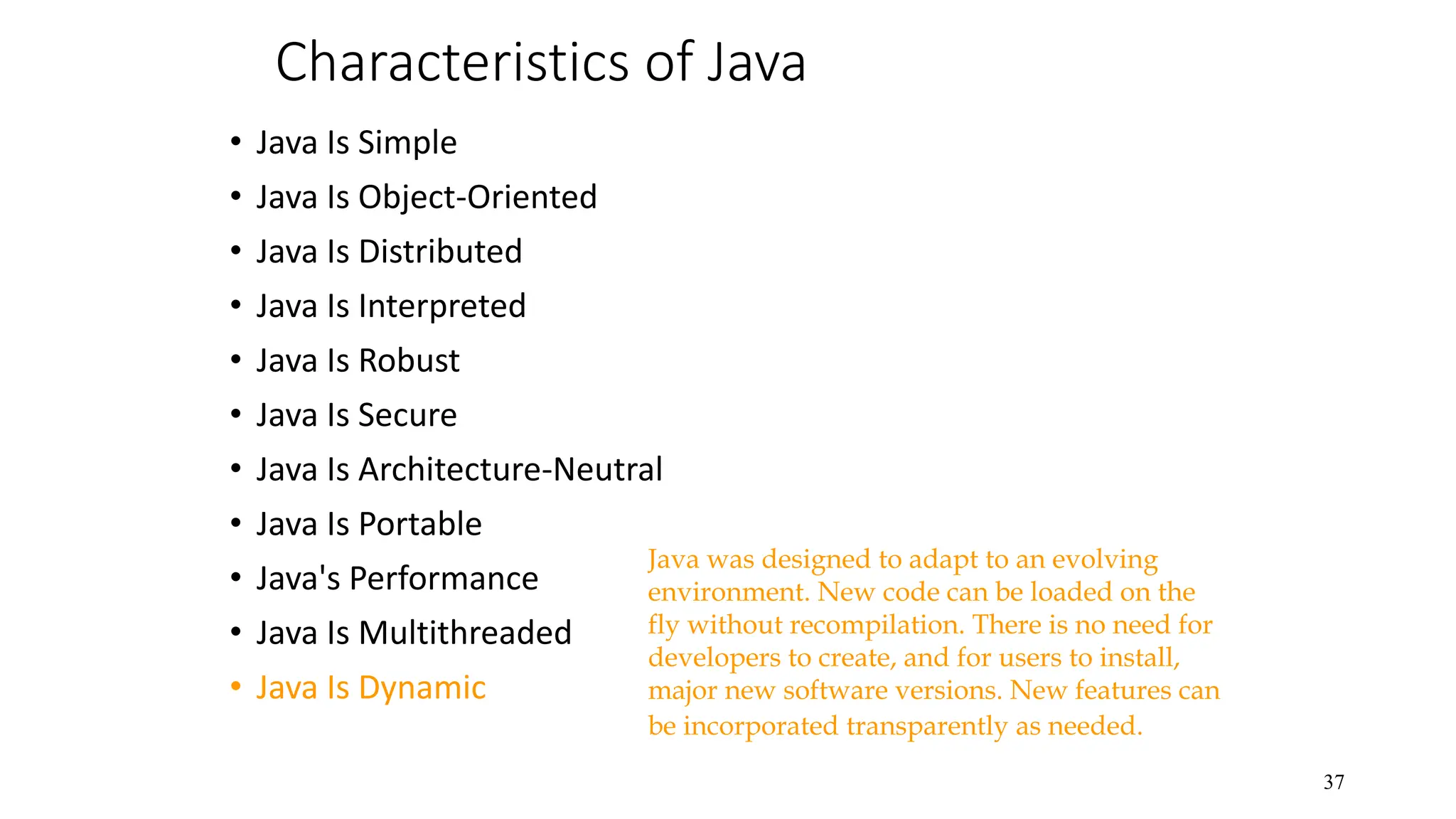
![JDK Versions 38 Version Date JDK Beta 1995 JDK 1.0 January 23, 1996[40] JDK 1.1 February 19, 1997 J2SE 1.2 December 8, 1998 J2SE 1.3 May 8, 2000 J2SE 1.4 February 6, 2002 J2SE 5.0 September 30, 2004 Java SE 6 December 11, 2006 Java SE 7 July 28, 2011 Java SE 8 (LTS) March 18, 2014 Java SE 9 September 21, 2017 Java SE 10 March 20, 2018 Java SE 11 (LTS) September 25, 2018[41] Java SE 12 March 19, 2019 Java SE 13 September 17, 2019 Java SE 14 March 17, 2020 Java SE 15 September 15, 2020[42] Java SE 16 March 16, 2021 Java SE 17 (LTS) September 14, 2021 Java SE 18 March 22, 2022 Java SE 19 September 20, 2022 Java SE 20 March 21, 2023 Java SE 21 (LTS) September 19, 2023 [43]](https://image.slidesharecdn.com/01slide-240409133549-31e70f07/75/Chapter-01-Java-Programming-Basic-Java-IDE-JAVA-INTELLIEJ-38-2048.jpg)


![A Simple Java Program // This program prints Welcome to Java! public class Welcome { public static void main(String[] args) { System.out.println("Welcome to Java!"); } } 41 Listing 1.1 Welcome](https://image.slidesharecdn.com/01slide-240409133549-31e70f07/75/Chapter-01-Java-Programming-Basic-Java-IDE-JAVA-INTELLIEJ-41-2048.jpg)

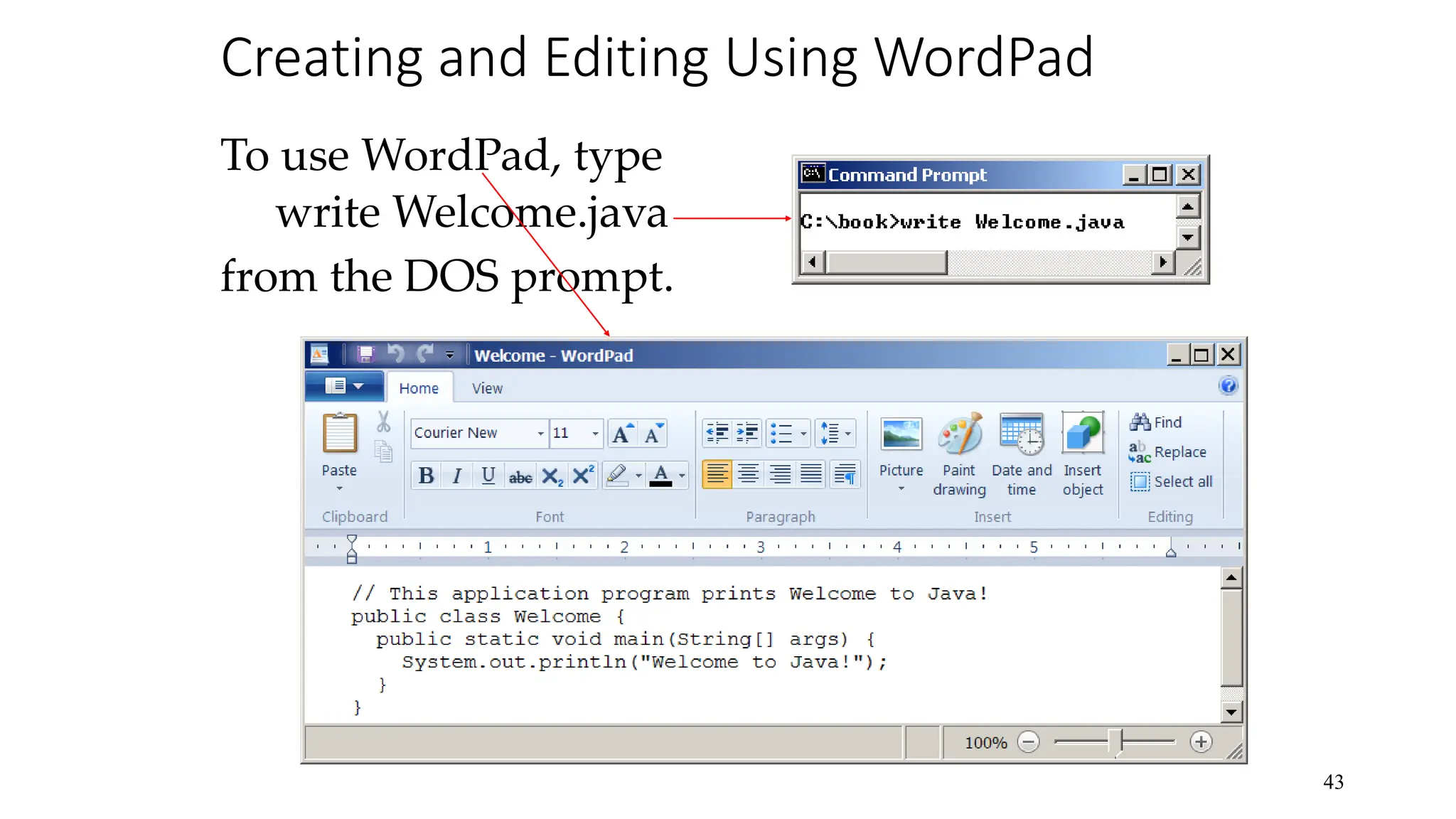
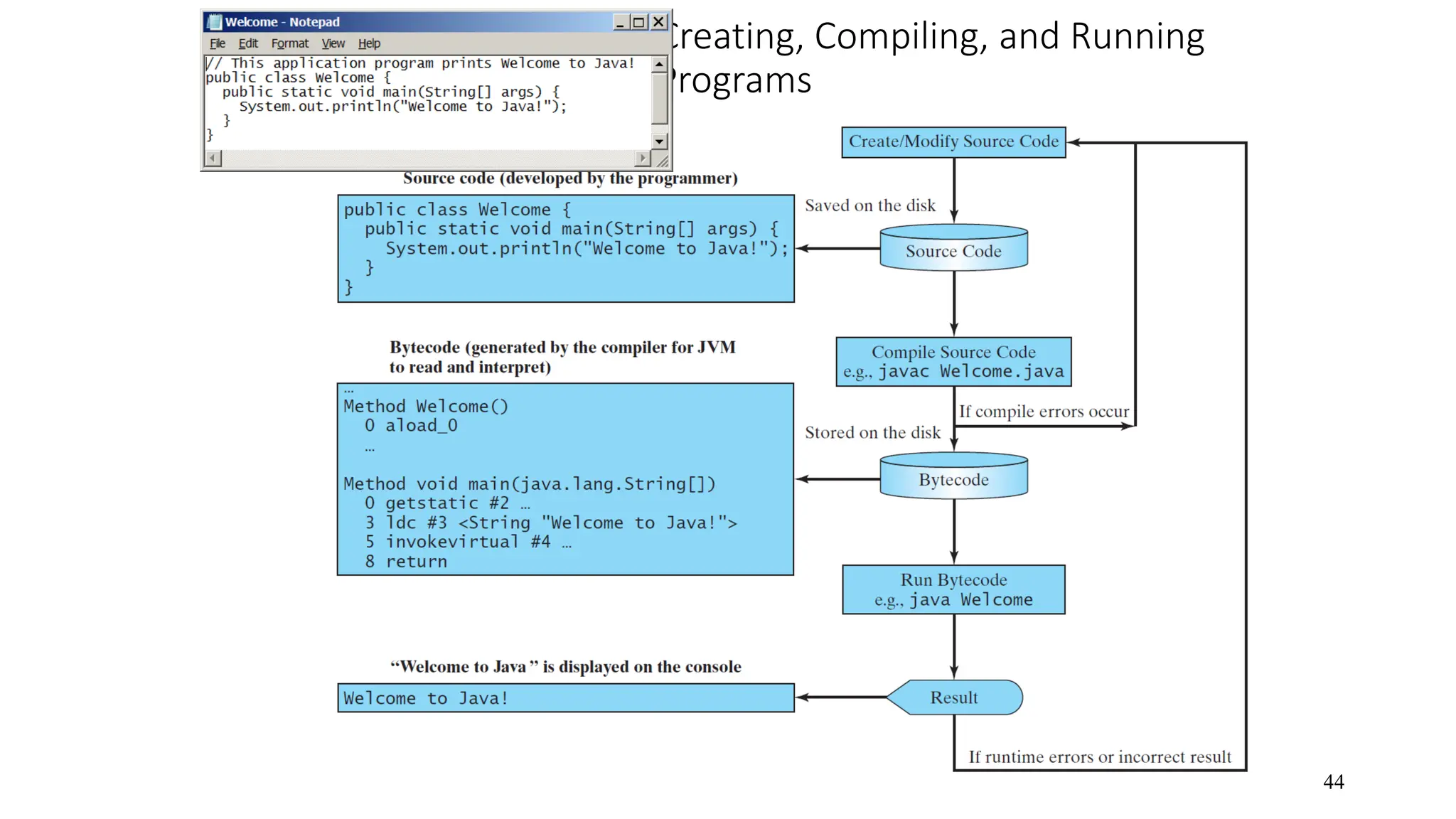
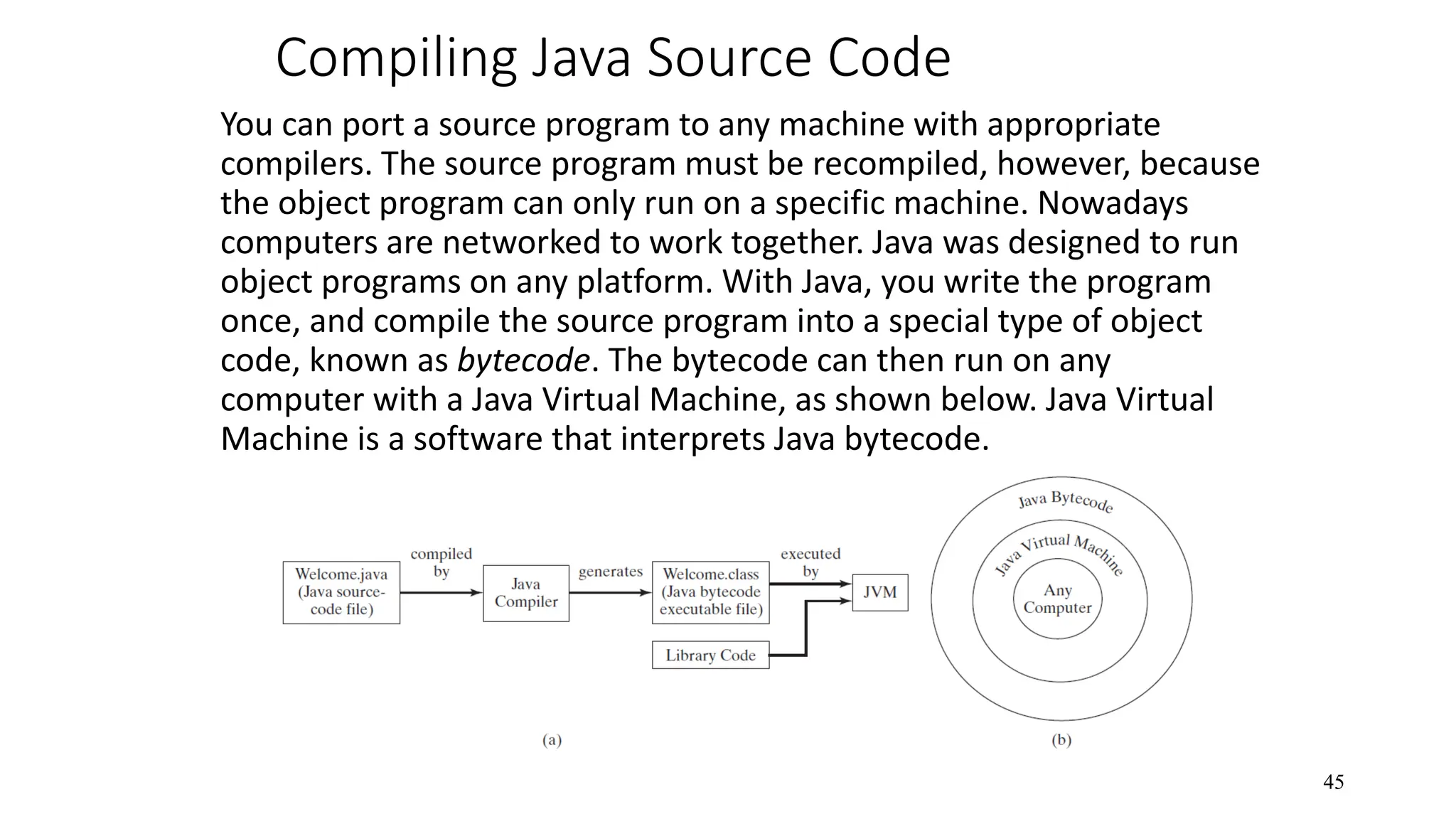
![Trace a Program Execution 46 // This program prints Welcome to Java! public class Welcome { public static void main(String[] args) { System.out.println("Welcome to Java!"); } } Enter main method](https://image.slidesharecdn.com/01slide-240409133549-31e70f07/75/Chapter-01-Java-Programming-Basic-Java-IDE-JAVA-INTELLIEJ-46-2048.jpg)
![Trace a Program Execution 47 // This program prints Welcome to Java! public class Welcome { public static void main(String[] args) { System.out.println("Welcome to Java!"); } } Execute statement](https://image.slidesharecdn.com/01slide-240409133549-31e70f07/75/Chapter-01-Java-Programming-Basic-Java-IDE-JAVA-INTELLIEJ-47-2048.jpg)
![Trace a Program Execution 48 // This program prints Welcome to Java! public class Welcome { public static void main(String[] args) { System.out.println("Welcome to Java!"); } } print a message to the console](https://image.slidesharecdn.com/01slide-240409133549-31e70f07/75/Chapter-01-Java-Programming-Basic-Java-IDE-JAVA-INTELLIEJ-48-2048.jpg)

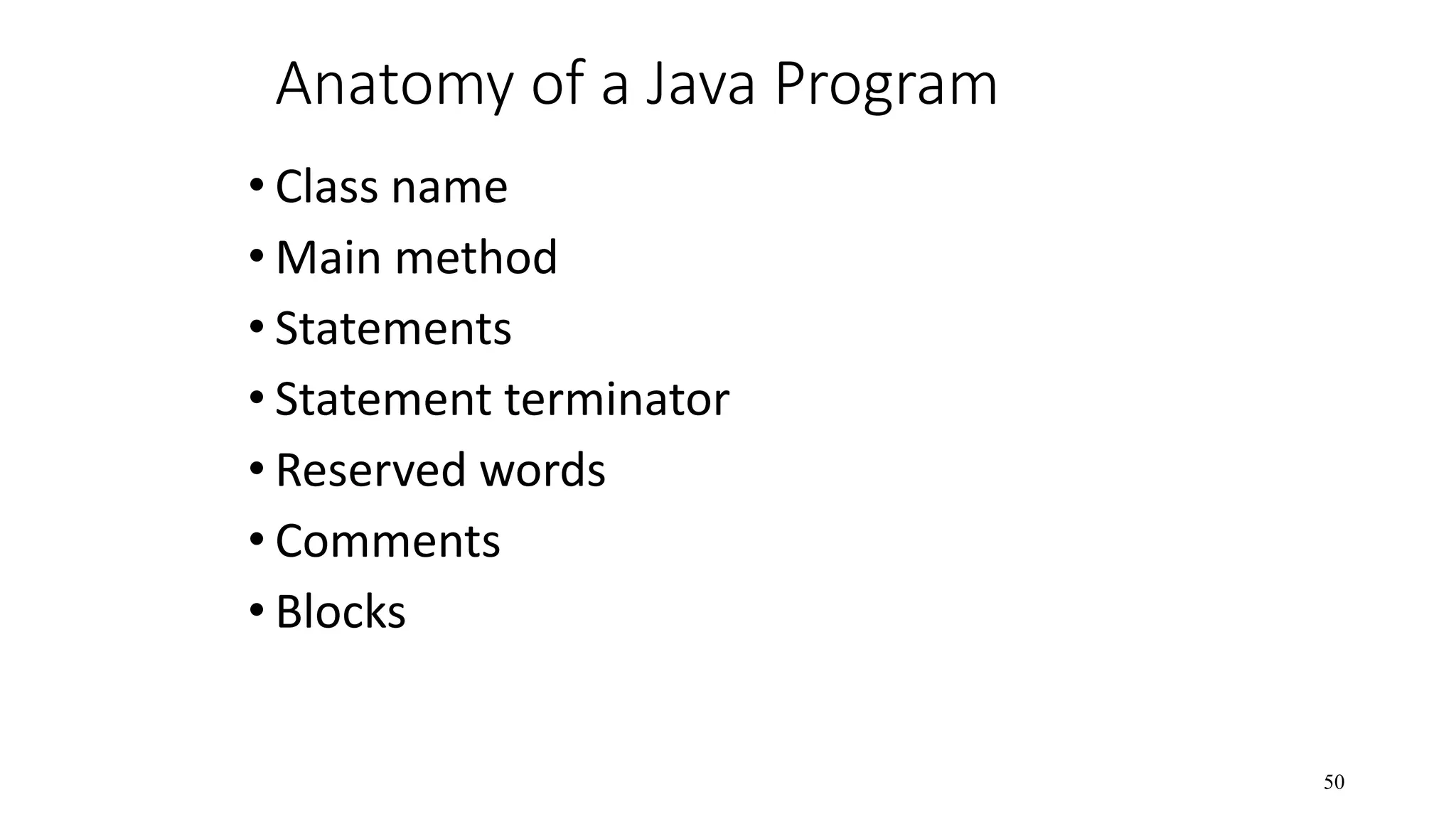
![Class Name Every Java program must have at least one class. Each class has a name. By convention, class names start with an uppercase letter. In this example, the class name is Welcome. 51 // This program prints Welcome to Java! public class Welcome { public static void main(String[] args) { System.out.println("Welcome to Java!"); } }](https://image.slidesharecdn.com/01slide-240409133549-31e70f07/75/Chapter-01-Java-Programming-Basic-Java-IDE-JAVA-INTELLIEJ-51-2048.jpg)
![Main Method Line 2 defines the main method. In order to run a class, the class must contain a method named main. The program is executed from the main method. 52 // This program prints Welcome to Java! public class Welcome { public static void main(String[] args) { System.out.println("Welcome to Java!"); } }](https://image.slidesharecdn.com/01slide-240409133549-31e70f07/75/Chapter-01-Java-Programming-Basic-Java-IDE-JAVA-INTELLIEJ-52-2048.jpg)
![Statement A statement represents an action or a sequence of actions. The statement System.out.println("Welcome to Java!") in the program in Listing 1.1 is a statement to display the greeting "Welcome to Java!“. 53 // This program prints Welcome to Java! public class Welcome { public static void main(String[] args) { System.out.println("Welcome to Java!"); } }](https://image.slidesharecdn.com/01slide-240409133549-31e70f07/75/Chapter-01-Java-Programming-Basic-Java-IDE-JAVA-INTELLIEJ-53-2048.jpg)
![Statement Terminator 54 // This program prints Welcome to Java! public class Welcome { public static void main(String[] args) { System.out.println("Welcome to Java!"); } } Every statement in Java ends with a semicolon (;).](https://image.slidesharecdn.com/01slide-240409133549-31e70f07/75/Chapter-01-Java-Programming-Basic-Java-IDE-JAVA-INTELLIEJ-54-2048.jpg)
![Reserved words Reserved words or keywords are words that have a specific meaning to the compiler and cannot be used for other purposes in the program. For example, when the compiler sees the word class, it understands that the word after class is the name for the class. 55 // This program prints Welcome to Java! public class Welcome { public static void main(String[] args) { System.out.println("Welcome to Java!"); } }](https://image.slidesharecdn.com/01slide-240409133549-31e70f07/75/Chapter-01-Java-Programming-Basic-Java-IDE-JAVA-INTELLIEJ-55-2048.jpg)
![Blocks 56 A pair of braces in a program forms a block that groups components of a program. public class Test { public static void main(String[] args) { System.out.println("Welcome to Java!"); } } Class block Method block](https://image.slidesharecdn.com/01slide-240409133549-31e70f07/75/Chapter-01-Java-Programming-Basic-Java-IDE-JAVA-INTELLIEJ-56-2048.jpg)
![Special Symbols 57 Character Name Description {} () [] // " " ; Opening and closing braces Opening and closing parentheses Opening and closing brackets Double slashes Opening and closing quotation marks Semicolon Denotes a block to enclose statements. Used with methods. Denotes an array. Precedes a comment line. Enclosing a string (i.e., sequence of characters). Marks the end of a statement.](https://image.slidesharecdn.com/01slide-240409133549-31e70f07/75/Chapter-01-Java-Programming-Basic-Java-IDE-JAVA-INTELLIEJ-57-2048.jpg)
![{ … } 58 // This program prints Welcome to Java! public class Welcome { public static void main(String[] args) { System.out.println("Welcome to Java!"); } }](https://image.slidesharecdn.com/01slide-240409133549-31e70f07/75/Chapter-01-Java-Programming-Basic-Java-IDE-JAVA-INTELLIEJ-58-2048.jpg)
![( … ) 59 // This program prints Welcome to Java! public class Welcome { public static void main(String[] args) { System.out.println("Welcome to Java!"); } }](https://image.slidesharecdn.com/01slide-240409133549-31e70f07/75/Chapter-01-Java-Programming-Basic-Java-IDE-JAVA-INTELLIEJ-59-2048.jpg)
![; 60 // This program prints Welcome to Java! public class Welcome { public static void main(String[] args) { System.out.println("Welcome to Java!"); } }](https://image.slidesharecdn.com/01slide-240409133549-31e70f07/75/Chapter-01-Java-Programming-Basic-Java-IDE-JAVA-INTELLIEJ-60-2048.jpg)
![// … 61 // This program prints Welcome to Java! public class Welcome { public static void main(String[] args) { System.out.println("Welcome to Java!"); } }](https://image.slidesharecdn.com/01slide-240409133549-31e70f07/75/Chapter-01-Java-Programming-Basic-Java-IDE-JAVA-INTELLIEJ-61-2048.jpg)
![" … " 62 // This program prints Welcome to Java! public class Welcome { public static void main(String[] args) { System.out.println("Welcome to Java!"); } }](https://image.slidesharecdn.com/01slide-240409133549-31e70f07/75/Chapter-01-Java-Programming-Basic-Java-IDE-JAVA-INTELLIEJ-62-2048.jpg)




![Block Styles Use end-of-line style for braces. 67 public class Test { public static void main(String[] args) { System.out.println("Block Styles"); } } public class Test { public static void main(String[] args) { System.out.println("Block Styles"); } } End-of-line style Next-line style](https://image.slidesharecdn.com/01slide-240409133549-31e70f07/75/Chapter-01-Java-Programming-Basic-Java-IDE-JAVA-INTELLIEJ-67-2048.jpg)
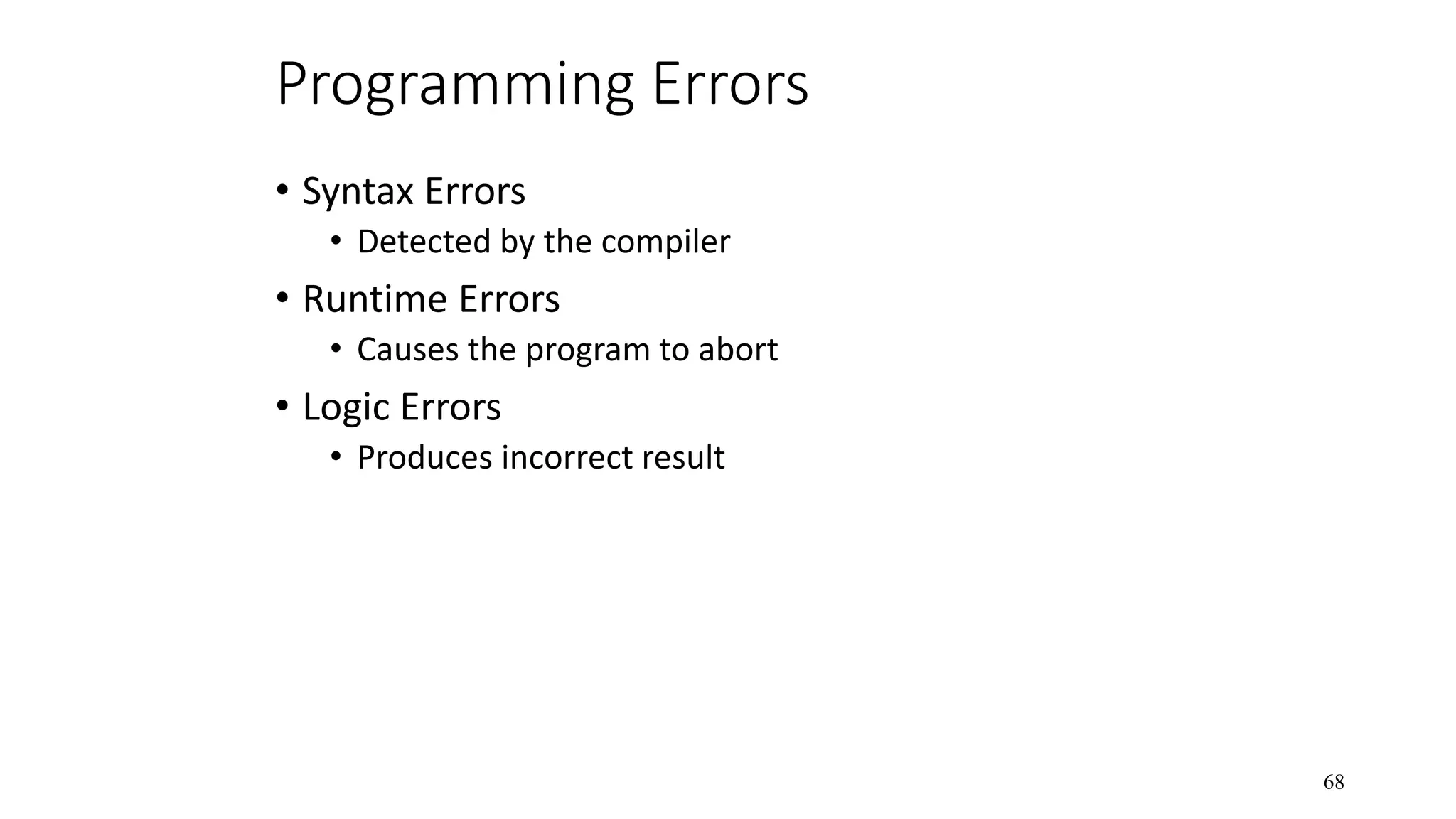
![Syntax Errors public class ShowSyntaxErrors { public static main(String[] args) { System.out.println("Welcome to Java); } } 69 ShowSyntaxErrors](https://image.slidesharecdn.com/01slide-240409133549-31e70f07/75/Chapter-01-Java-Programming-Basic-Java-IDE-JAVA-INTELLIEJ-69-2048.jpg)
![Runtime Errors public class ShowRuntimeErrors { public static void main(String[] args) { System.out.println(1 / 0); } } 70 ShowRuntimeErrors](https://image.slidesharecdn.com/01slide-240409133549-31e70f07/75/Chapter-01-Java-Programming-Basic-Java-IDE-JAVA-INTELLIEJ-70-2048.jpg)
![Logic Errors public class ShowLogicErrors { public static void main(String[] args) { System.out.println("Celsius 35 is Fahrenheit degree "); System.out.println((9 / 5) * 35 + 32); } } 71 ShowLogicErrors](https://image.slidesharecdn.com/01slide-240409133549-31e70f07/75/Chapter-01-Java-Programming-Basic-Java-IDE-JAVA-INTELLIEJ-71-2048.jpg)